Contrasting color caterpillars are often yellow and black. Many caterpillars are green but those that are yellow and black can sometimes prove poisonous to predators.
Poison glands are rare on yellow and black caterpillars as they primarily rely on vivid coloring to keep predators away.
Some caterpillars come in additional colors, primarily brown, red, and white.
Alternating colors are specific to others during various growth stages.
Some caterpillars are only yellow and black in a certain growth period before pupation.
Most yellow and black caterpillars in North America are seen in one or multiple, sometimes overlapping, broods each year.
They have specific host plants they feed on and they appear in specific periods.
Table of Contents
1. Police Car Moth Caterpillar
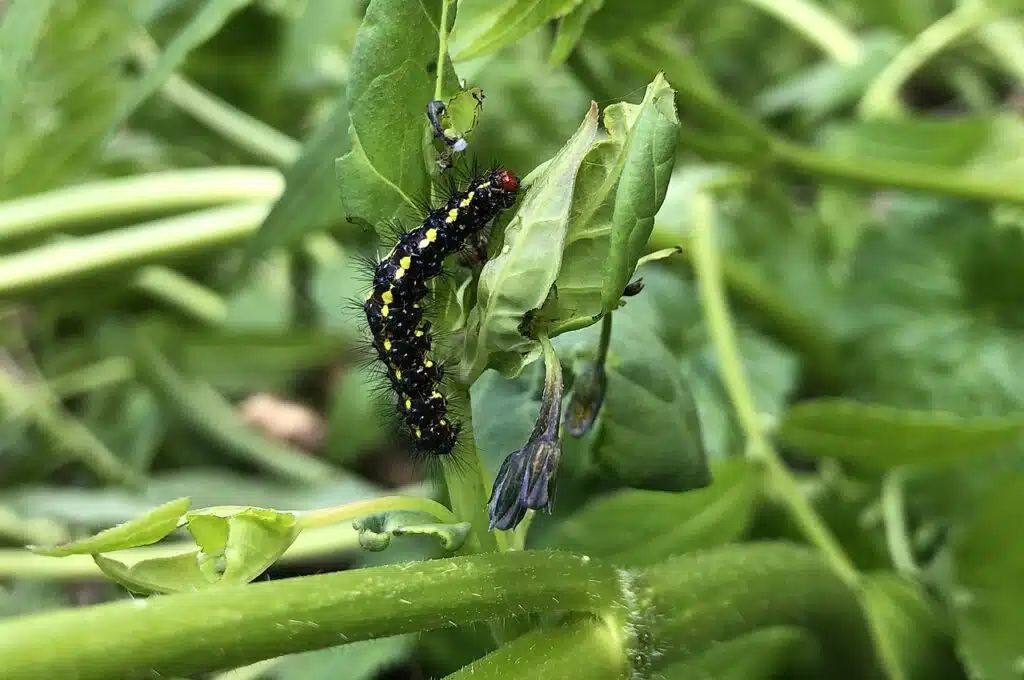
Police Car Moth Caterpillars (Gnophaela vermiculata) are dominated by black and yellow colors.
A base black color is contrasted by larger yellow patches across the lateral sides and a brown head.
These remain the colors of the caterpillar up to its final growth stages when it finally takes on black and white colors which are further seen on the emerging moth.
Host plant preferences influence the coloring of the species as it’s often seen on yellow flowers as a caterpillar and even as an adult moth.
Gromwells and stickseeds are among the common host plants of the caterpillar.
Adult moths are seen on some of the most common yellow flowers in open areas, goldenrods.
2. Dagger Caterpillar
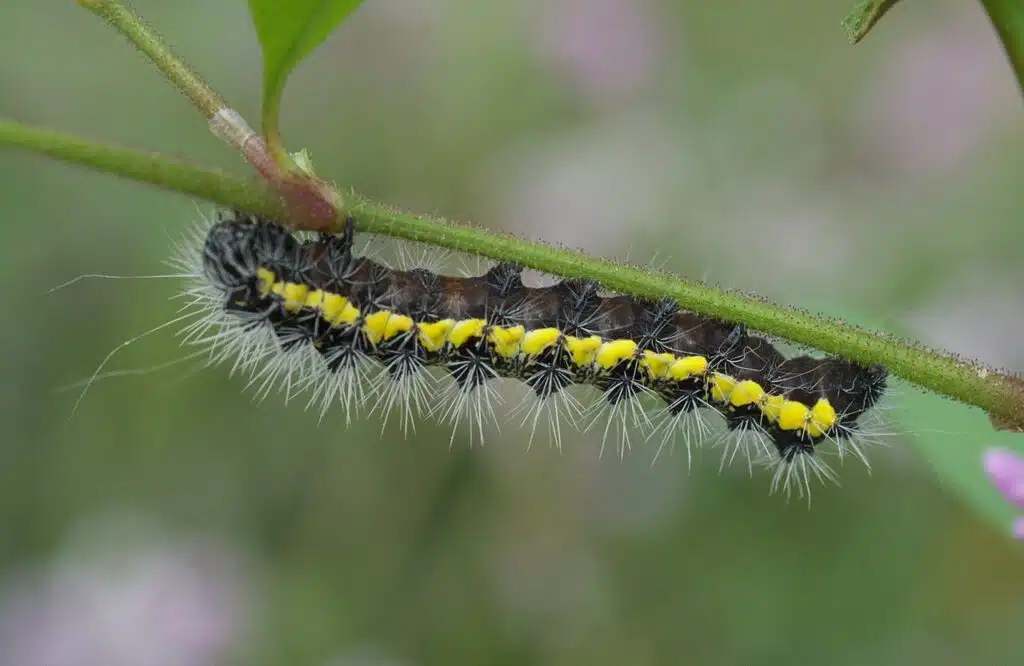
Smeared Dagger Caterpillars (Acronicta oblinita) are sometimes known to sting. Sharp spikes across the body make the species less appealing to its predators.
Yellow and black colors are specific to the Smeared Dagger Caterpillar at various growth stages.
This is a species that has alternating longitudinal black and yellow bands across its body. Red bands appear in the later growth stages across its body as well.
The pupal stage of the species is marked by dark brown coloring.
Smeared Dagger caterpillars feed on grasses, tree leaves, and various shrubs.
These caterpillars are a minor pest of corn and clover.
3. Red-humped Caterpillar
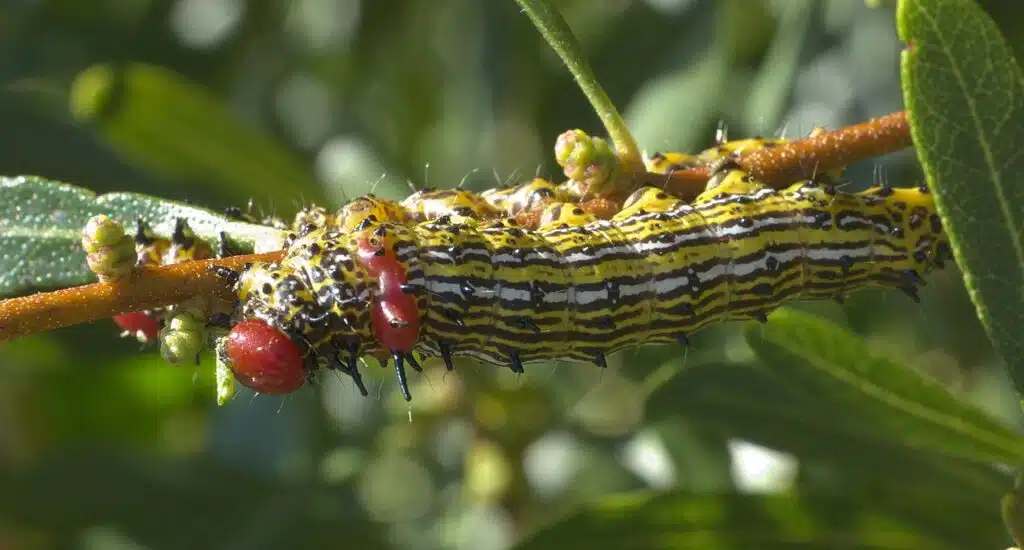
Red-humped Caterpillars (Oedemasia concinna) are a known type of pest across Southern US states. It’s a major crop pest in some areas of California.
It begins life as a small spherical yellow egg laid in clumps, on the underside of leaves.
It then grows to a black and yellow caterpillar with either a red or a brown head.
This species feeds on the leaves of walnut, plum, pear, willow, and other trees.
It impacts crops in their early stages the most, as this is when the Red-humped Caterpillar feeds and lives in groups.
Pesticides are routinely used against this species. Biological control measures are mostly based on parasitic wasp management.
4. Yellow-necked Caterpillar
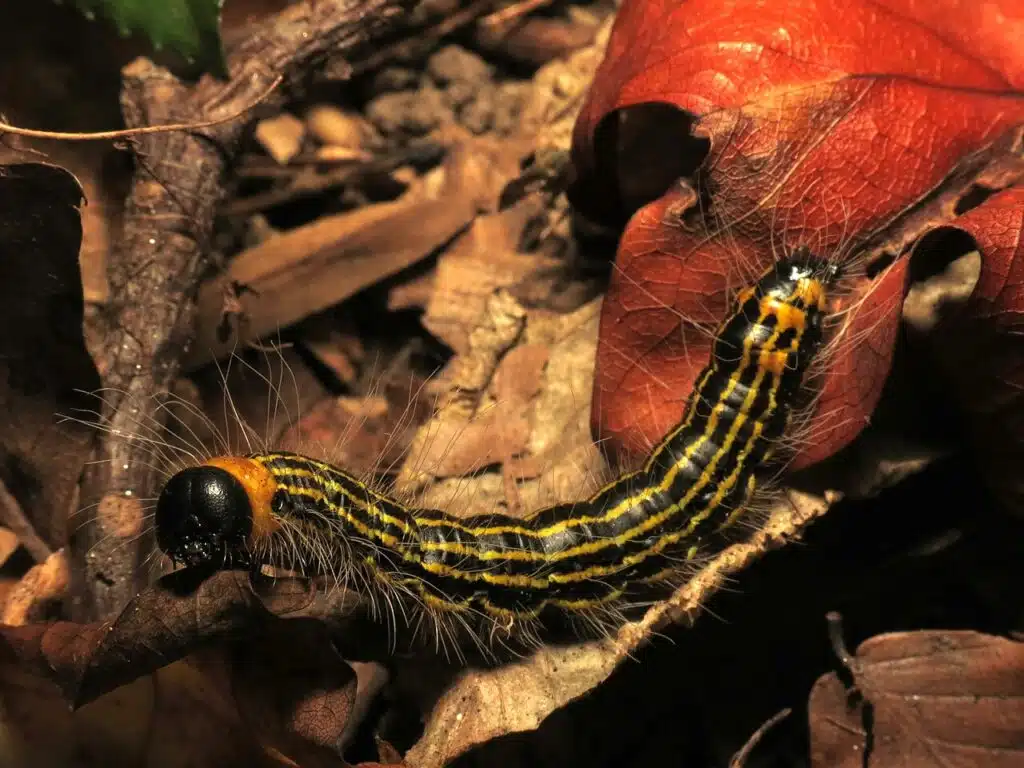
This species of caterpillar (Datana ministra) becomes black and yellow as it grows.
It appears brown and yellow as it emerges to become black with yellow stripes and brown spots in its later growth stages.
This species prefers willow and oak tree leaves which it consumes almost entirely.
Overwintering in a pupal stage is specific to the species. The pupa forms in the ground, under host oak and willow trees.
The pupa remains in the ground until the first weeks of spring.
Yellow-necked Caterpillars are generally found in Eastern North America with a growing presence on the Pacific Coast as well.
5. Brown-hooded Owlet Caterpillar
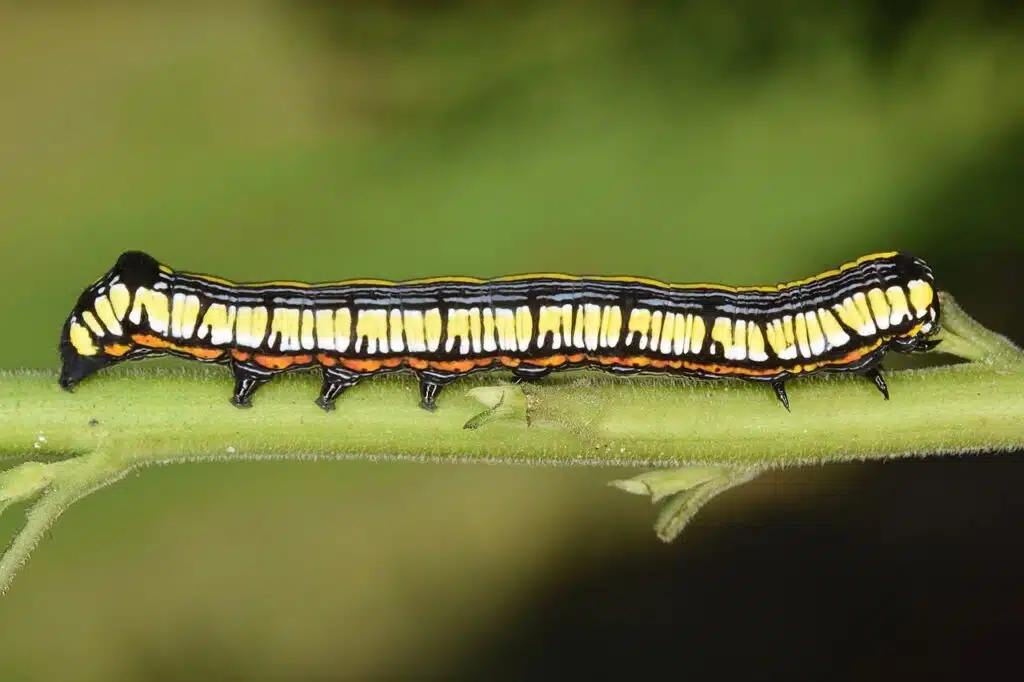
A combination of yellow and black contrasting colors makes the Brown-hooded Owlet Caterpillar (Cucullia convexipennis) unique.
This species has yellow bands and stripes. The bands have white tips.
Multiple black stripes and bands are also seen across its body in its first growth stages to have 2 additional brown bands in its later growth stages.
The ventral side of its body is marked by contrasting black and yellow stripes as well.
Much of the natural habitat of the species impacts its coloring.
Brown-hooded Owlet Caterpillars are mostly seen on goldenrod. Its preferred habitat covers dry areas of the Northeastern United States.
6. Cinnabar Moth Caterpillar
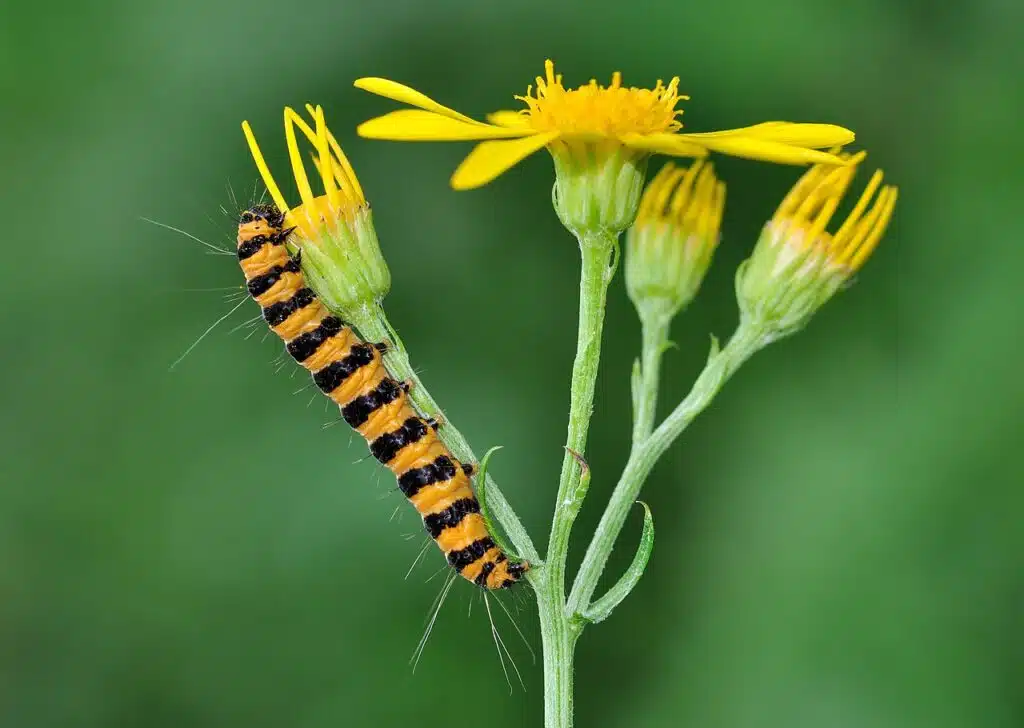
Yellow and black coloring dominates the appearance of Cinnabar Moth Caterpillars (Tyria jacobaeae) through their growth stages.
Alternating black and yellow bands cover the body of the species.
Adult moths have black and red colors.
The caterpillars of the Cinnabar Moth are known to be cannibalistic. They eat other larvae of the same species found on the same plant, typically ragwort.
A high level of defoliation and high appetite makes this species consume its host plant completely before pupation.
As a result, the caterpillar turns cannibalistic with no other available food.
These caterpillars also have natural predators such as various types of red ants.
7. Monarch Caterpillar
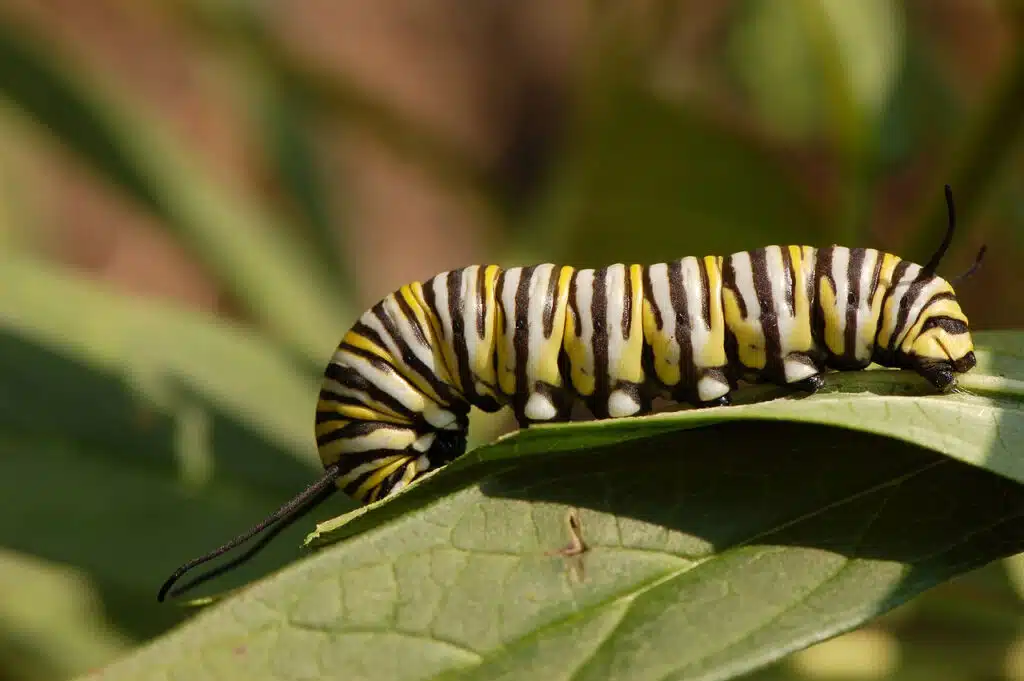
Monarch butterflies (Danaus plexippus) are some of the most common species in North America. Their caterpillar represents one of the yellow and black species that’s easy to spot as a result.
Alternating black, yellow, and white bands make up the bulk of the coloring this species is known for.
Thin yellow, white, and black bands cover its body.
Monarch Caterpillars are a known species of milkweeds, which may be poisonous to other species.
These caterpillars absorb the poisons in the plant which give it a foul taste to its predators.
While known to use milkweeds as a host species, Monarch caterpillars can also eat thistles, goldenrod, and a wide range of asters.
Monarch Caterpillars are among the few species with green pupa with yellow bands.
8. White-marked Tussock Moth Caterpillar

Black and yellow colors are also specific to the White-marked Tussock Moth Caterpillar (Orgyia leucostigma).
This species has contrasting colors and 4 yellow defensive glands on its mid-dorsal section close to its head.
Black and white or black and yellow longitudinal stripes cover the body of the species.
Black tufts are also spotted on a caterpillar that’s covered in long scarce white or yellow hairs.
You can find White-marked Tussock Moth Caterpillars in woodlands at various altitudes.
Low-altitude deciduous woodland trees are hosts for the species, as are high-altitude coniferous trees.
9. Western Sheep Moth Caterpillar
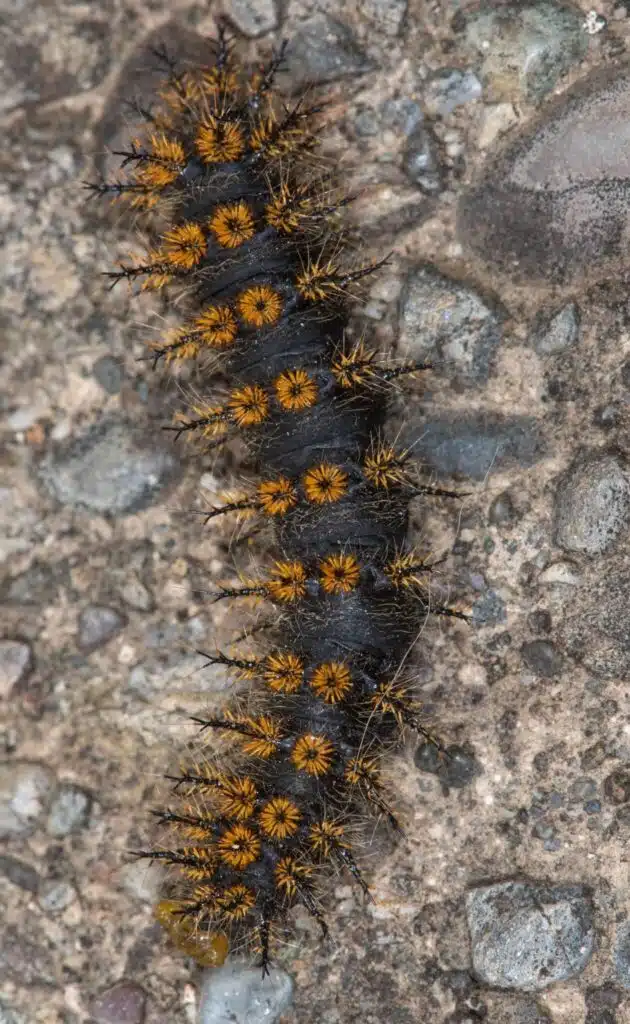
Western US territories aren’t home to as many black and yellow caterpillars (Hemileuca eglanterina) as those in the East.
The Western Sheep Moth Caterpillar is among the notable exceptions.
A black body with yellow spikes is specific to this type of caterpillar as it first emerges.
It slowly turns purple as it matures.
The caterpillar’s color is sometimes influenced by its host plant, which can be lilac or different types of current.
The caterpillar is first seen at the end of May with the first months of the species emerging only in June.
10. Cloudless Sulphur Caterpillar
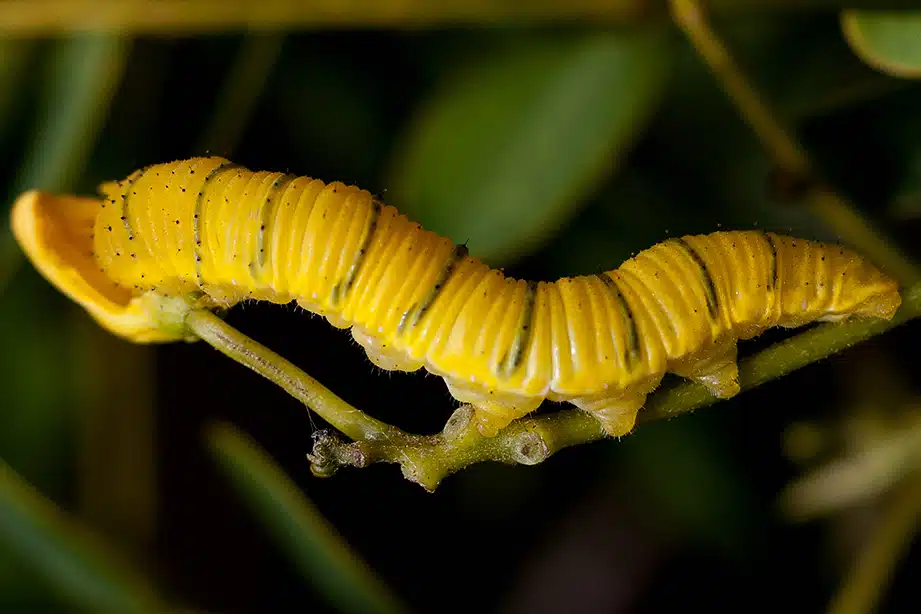
Cloudless Sulphur butterflies (Phoebis sennae) are among the most common migratory species of North America.
They can lay eggs on many types of flowers and shrubs.
Some of these host plants grow yellow flowers, which makes the caterpillar easily blend in with its environment.
The green color is specific to the Cloudless Sulphur caterpillar as it emerges. It slowly turns yellow with a few black dorsal bands.
The species turns green again when it enters its pupal stage.
Various types of native and introduced plants are ideal hosts both for the caterpillar and the pupa.
Pea species such as Florida Keys Sensitive Pea and Privet Wild Sensitive Peas are among its hosts.
11. Fir Tussock Moth Caterpillar
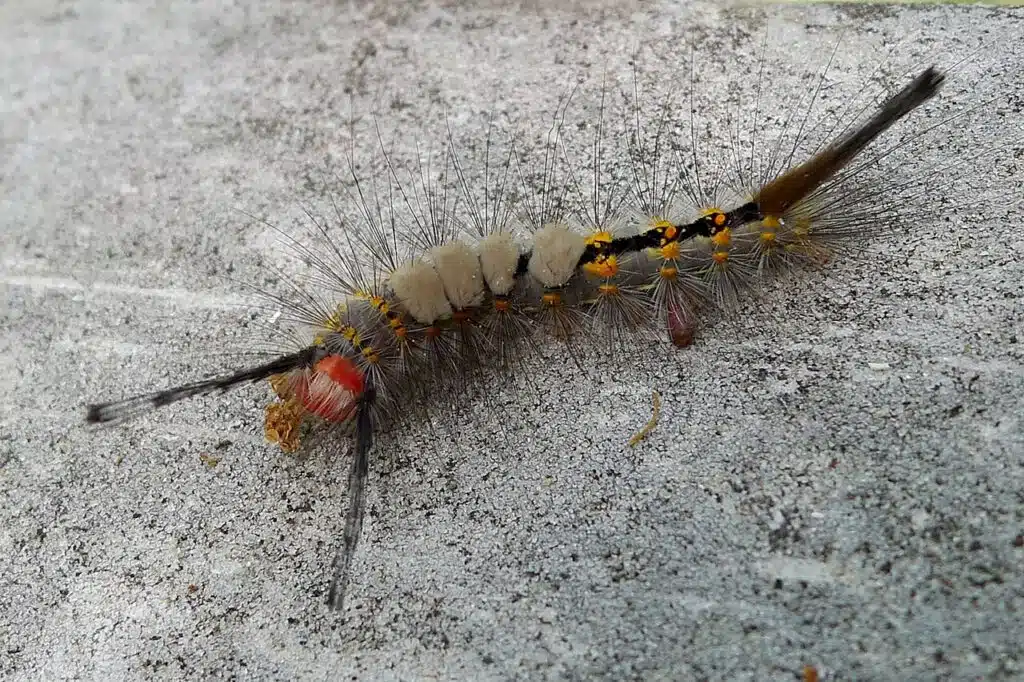
Fir Tussock Moth (Orgyia detrita) is one of the species known to cause skin irritation. While this doesn’t happen in all cases, it’s still best to avoid touching the caterpillar.
A yellow and a gray morph are both specific to the United States.
In Florida alone, the species comes in a gray and orange form and a yellow and black form.
Most of its body is yellow, with a black dorsal stripe, black tufts, and long yellow hairs.
In some cases, these yellow hairs may be cream or even white.
The Fir Tussock Moth Caterpillar can potentially defoliate its host tree.
This is a species that creates silk and uses its hairs and tufts to build the pupa before emerging as a gray-brown moth.
12. White-lined Sphinx Caterpillar
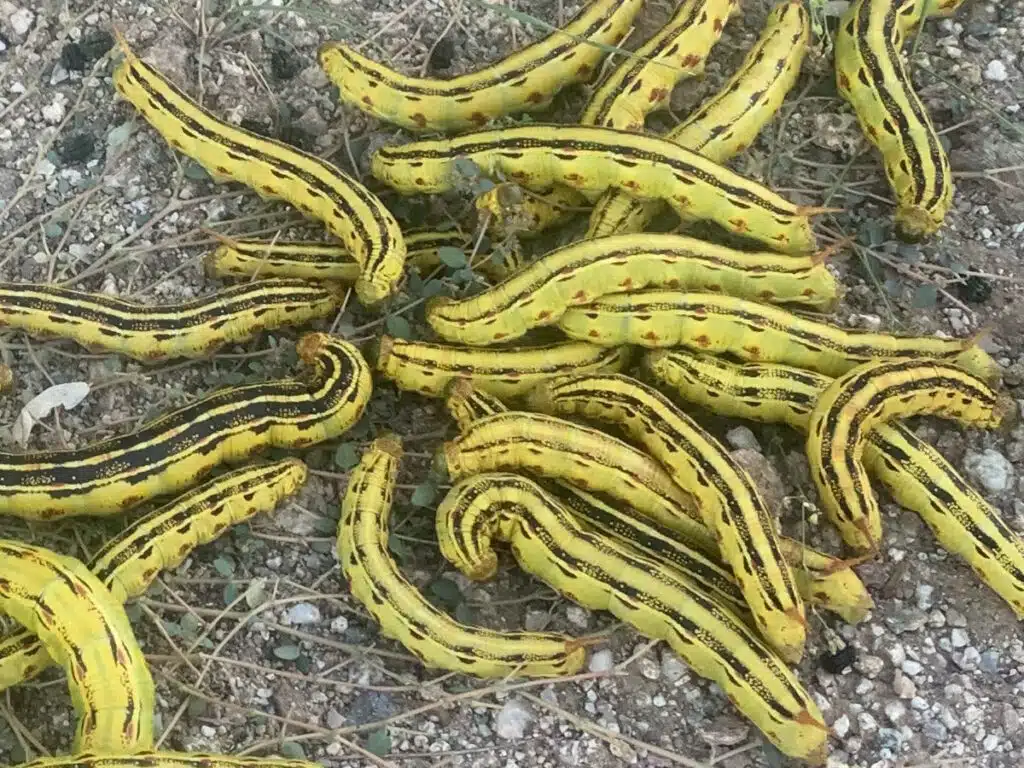
White-lined Sphinx Caterpillars (Hyles lineata) also come in different colors, similar to Fir Tussock Moth Caterpillar.
The species is black at first, with contrasting orange, yellow, or green marks.
It can then turn either green or yellow.
The yellow morph of the species has black longitudinal stripes and tiny black dots across its body.
Brown spots and green areas remain visible, even if the main color of the species is eventually yellow in its late growth stages.
This is a species known for its impact on the ecosystem, which can be variable depending on its host.
A range of trees and legumes are its viable hosts. Willows and tomatoes are examples of White-lined Sphinx Caterpillar hosts.
13. California Tortoiseshell Caterpillar
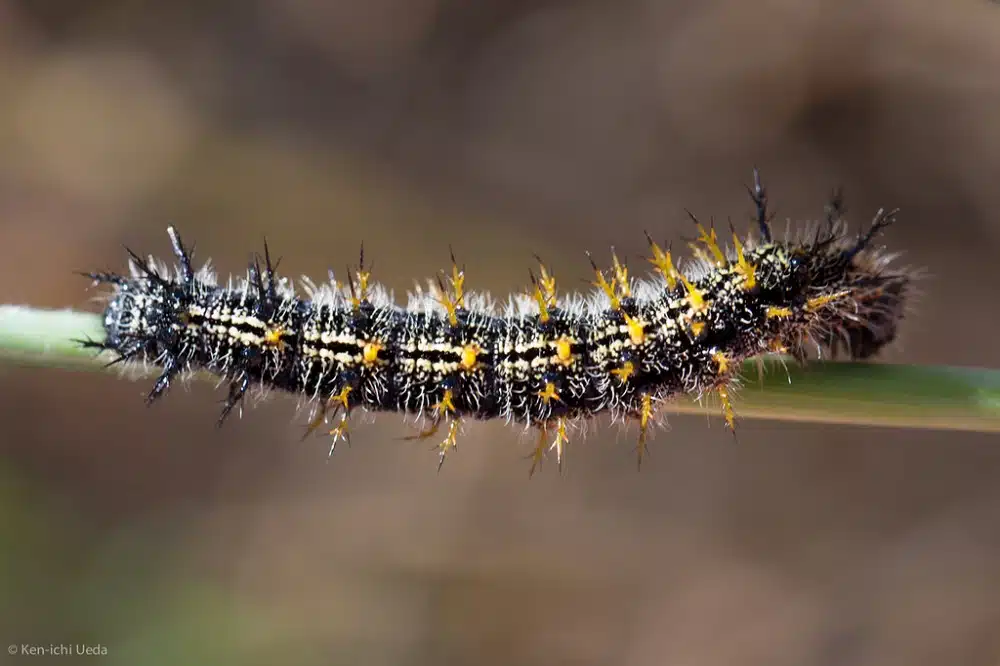
You can find California Tortoiseshell Caterpillars (Nymphalis californica) in a Western habitat across North America from British Colombia to California.
This is a species marked by dark coloring through its life stages. It’s mostly black as a caterpillar and brown, gray, and black as an adult.
California Tortoiseshell Caterpillars have a black base color with yellow, cream, and orange spots of different sizes across its body.
Bushes, woodland, open areas, and even arid areas can be dry habitats for the species.
It lives on various types of hosts, most likely in the wild lilac family.
California Tortoiseshell Caterpillars overwinter even in Southern habitats, only emerging in April.
14. Soldier Caterpillar
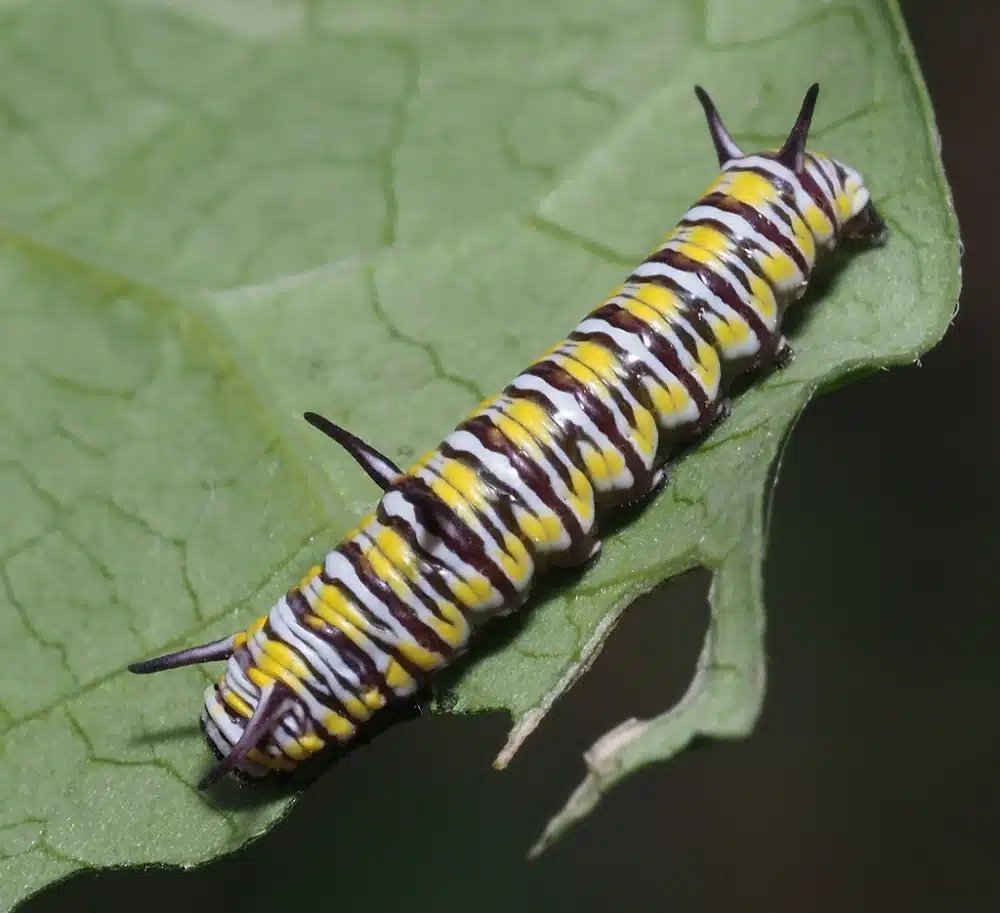
There’s considerable resemblance between the Soldier Caterpillar (Danaus eresimus) and Monarch Caterpillars.
Coloring and the banded patterns across the body of this species resemble Monarch Caterpillars.
Alternating black, white, and black bands are seen on the caterpillar.
The underside of the species is mostly black.
While the habitat of Solider and Monarch caterpillars can overlap, these species are met by a third Queen species that bears a physical resemblance.
Various plant species are hosts of the Solider Caterpillar. All of these are flowering plants.
You can find Solider Caterpillars on latex plants, white twine vines, and on wormgrass.
15. West Coast Lady Caterpillar
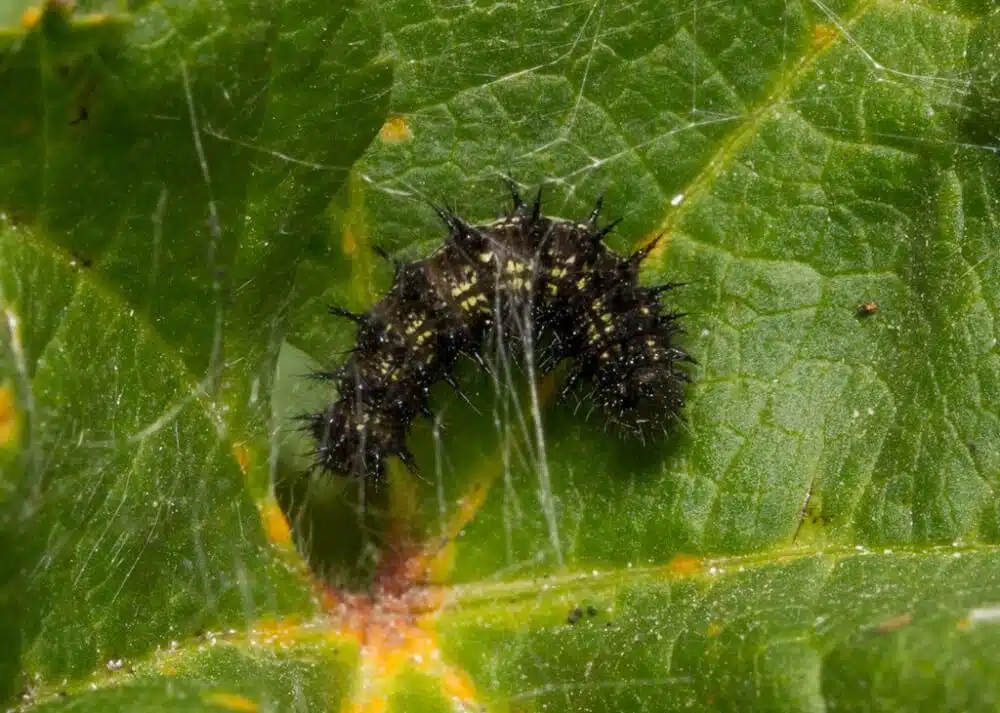
West Coast Lady Caterpillars (Vanessa annabella) begin life as green eggs.
These are a species of caterpillars that are mostly black throughout their growth stages.
Secondary colors are the ones that vary as the species matures.
West Coast Lady Caterpillars are black and yellow at first, slowly turning into black and brown caterpillars.
An initial spike-free body turns to a dark body covered in spikes as the species approaches its pupal stage.
The pupa of the species is black, brown, and green.
16. Anise Swallowtail Caterpillar
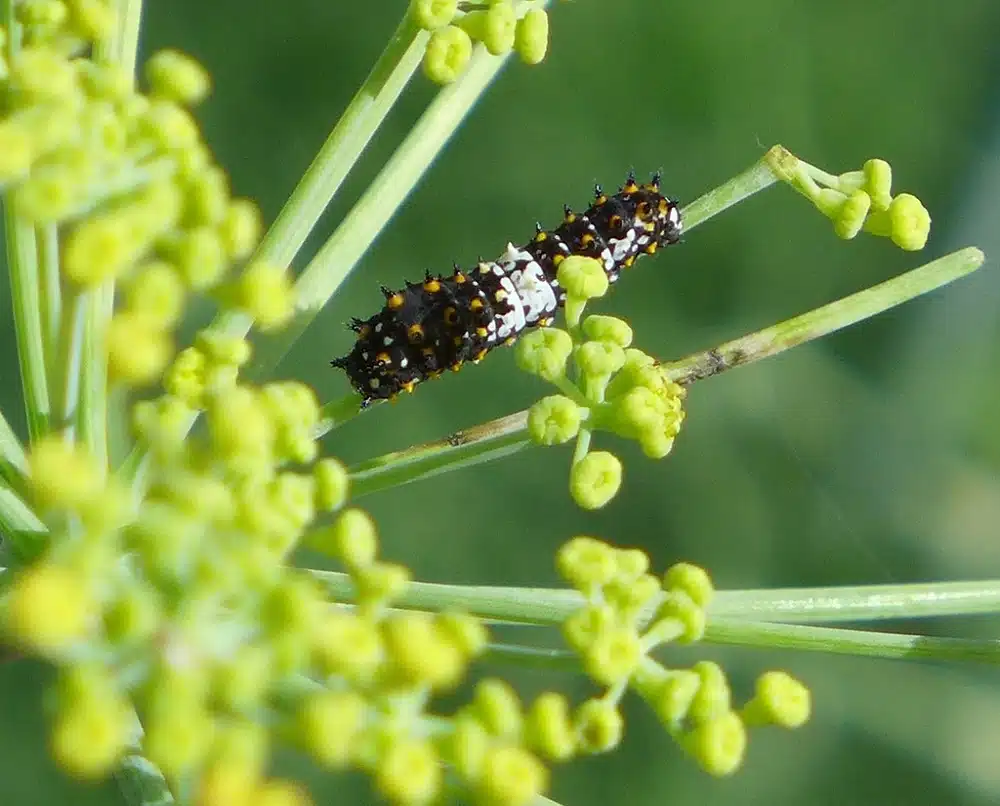
Sweet fennel and other types of carrot-group plants are all hosts of the Anise Swallowtail Caterpillar (Papilio zelicaon).
This is the caterpillar of one of the largest yellow and black butterflies in North America.
Yellow and black colors are tertiary on the caterpillar, which is mostly green.
Tiny yellow and black dots are seen across the body of this caterpillar.
These dots form dorsal bands and are also seen on the lateral sides of the caterpillar.
A base green color with yellow marks is specific to the pupa of the species.
17. Queen Caterpillar
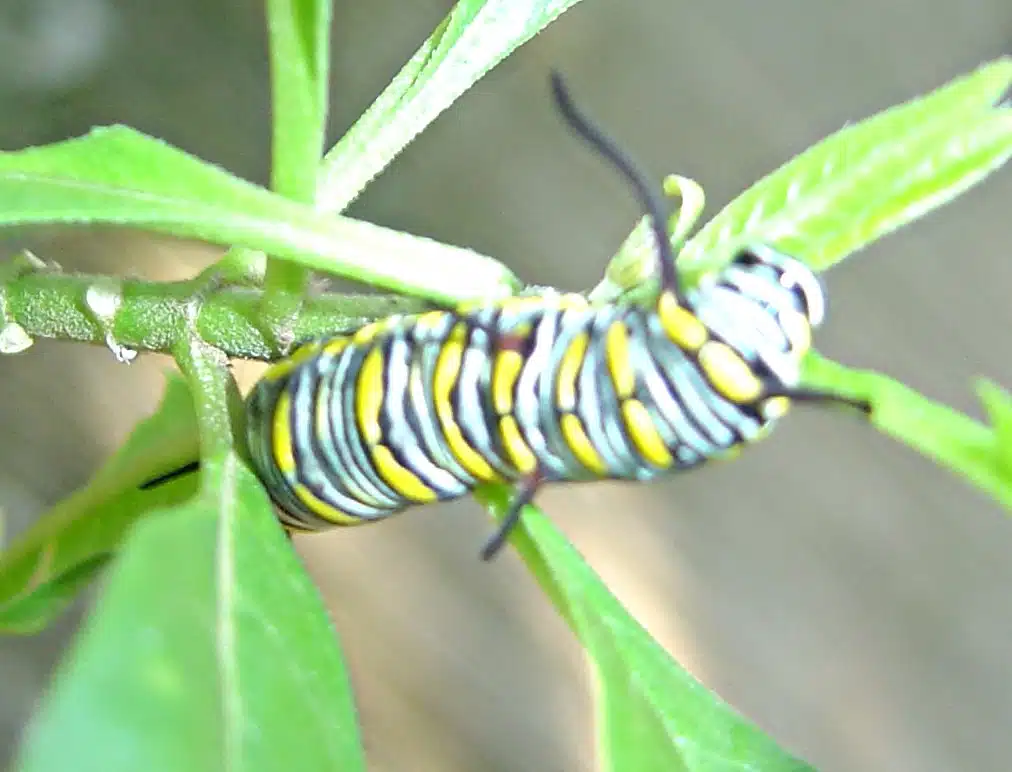
Queen caterpillars (Danaus gilippus) bear a major physical resemblance to Monarch and Solider Caterpillars.
This species has a black body with alternating white bands with large yellow dorsal spots in the first growth stages.
The spots become yellow bands as the species grows.
Black pairs of tentacles are also seen across its body. These tentacles grow longer as the caterpillar grows.
Various species of milkweed such as honey vine are the hosts of this common species.
18. Eastern Comma Caterpillar
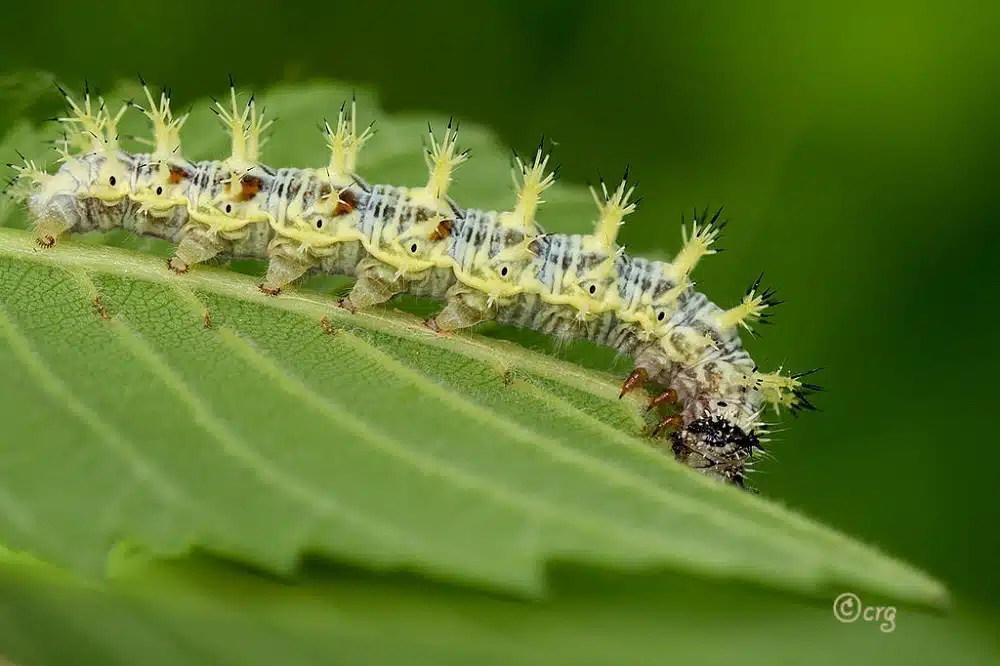
Eastern Comma Caterpillars (Polygonia comma) use common hops as host plants.
Native to North America, the Eastern Comma Caterpillar also relies on the nettle as a host.
Damages to these hosts are minimal, mostly tied to consuming small parts of outer leaves.
This is a species of mostly black caterpillars with yellow irregular marks across the body.
Yellow spines and small brown dots also form on the dorsal side of the species as it matures.
19. Black Swallowtail Caterpillar
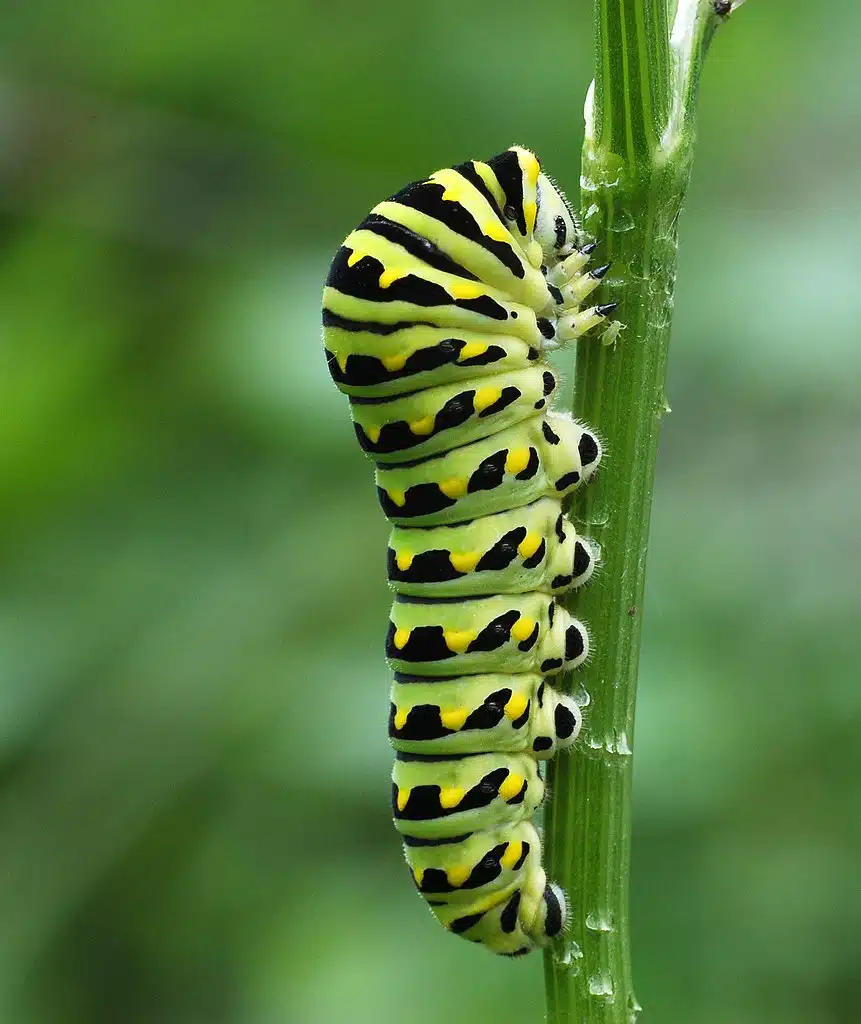
Black Swallowtail Caterpillars (Papilio polyxenes) have a complete cycle when the adult butterfly emerges with coloring similar to the early-stage caterpillar.
The Black Swallowtail Caterpillars are black with orange-red spots at first.
This is also the color of the Black Swallowtails Butterfly’s body.
As it grows, the caterpillar becomes green and hairless. Black and yellow dots forming bands are seen across its body.
This species uses the chemical odors of plants to only select the most suitable hosts for its eggs.
Caterpillars grow on carrot-family plants.
20. American Snout Caterpillar
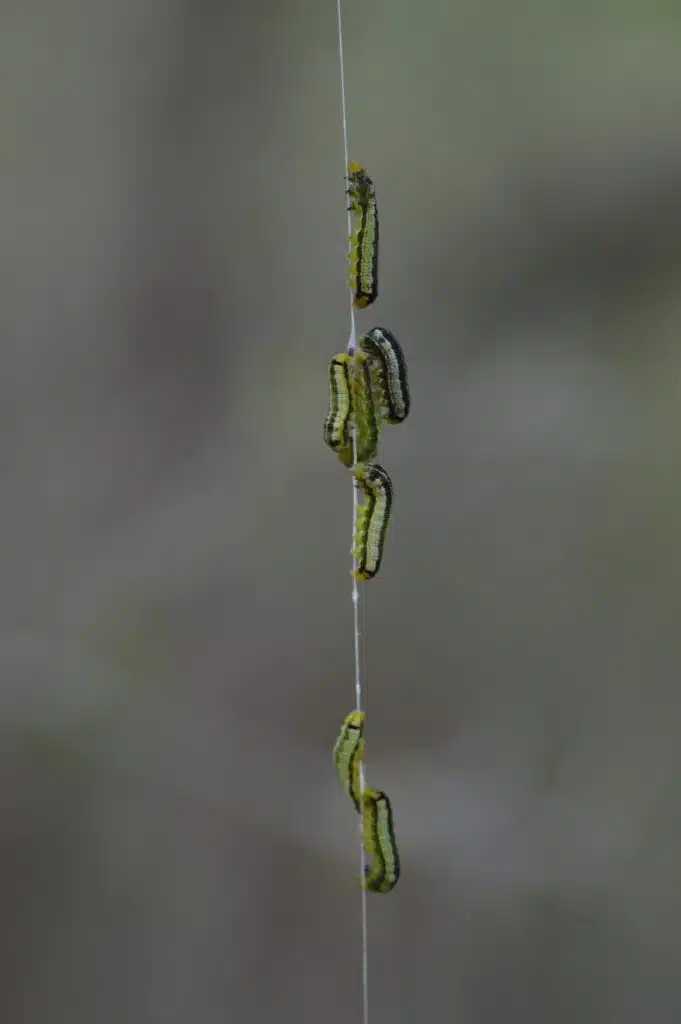
American Snout Caterpillars (Libytheana carinenta) are found in bright and dark forms.
The bright form of the species has a green body with yellow bands while the dark form is black with yellow bands and dots.
The anal plate of the dark form is also yellow.
Known for its migratory habits and its elongated snout as a butterfly, this caterpillar feeds on Northern and Southern American hackberry.
21. Question Mark Caterpillar
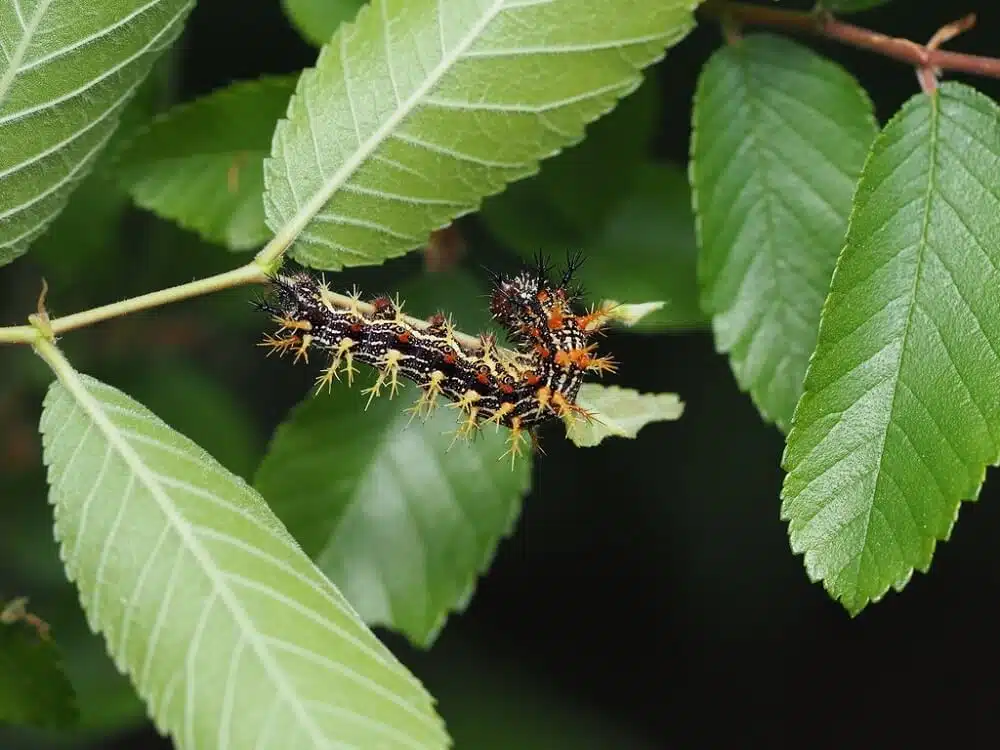
Question Mark Butterflies (Polygonia interrogationis) and caterpillars use camouflaging colors at all life stages.
The adult is known to mimic dead brown leaves while the black caterpillar has spines that make it look unappealing to predators.
These spines can be yellow, but they may also be brown or red-brown.
Yellow stripes and marks are also common on the black body of the mature caterpillar.
Various species of elm and hackberry trees are the common hosts of the species.
22. Spring White Caterpillar
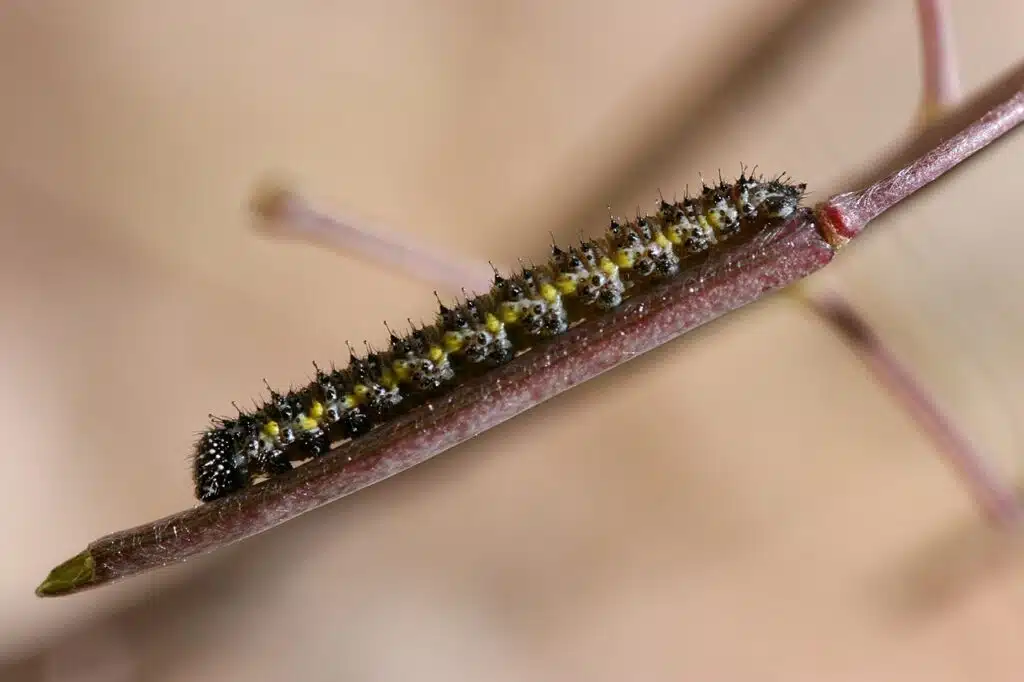
Found across Western North America, this (Pontia sisymbrii) is a species also marked by yellow and black colors.
This species begins life as a red-brown elongated egg on a leaf.
It then turns into a pale yellow caterpillar with a black head.
As it grows, it changes coloring to a black, yellow, and white species. White and yellow bands are specific to the caterpillar.
Yellow coloring isn’t seen on the mostly white and black adults.
Caterpillars of the species can be found on all types of mustard plants, except the cultivated genuses.
23. Agreeable Tiger Moth Caterpillar
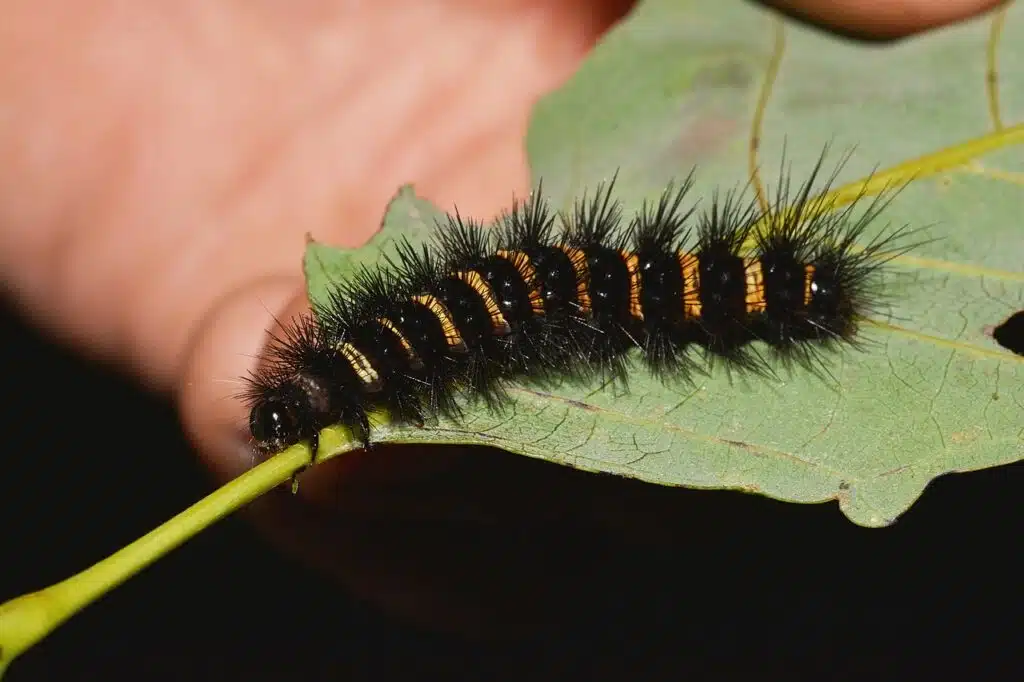
As Spring White moths, the Agreeable Tiger Moth (Spilosoma congrua) is also mostly white.
These species have darker, often black, caterpillars.
The Agreeable Tiger Moth Caterpillar has alternating black and yellow or orange bands across its body.
Handing the species isn’t recommended due to its spiny body.
This black caterpillar is found in various East US herbs such as dandelions.
Agreeable Tiger Moth caterpillars are first seen in April. They remain active until August or early September.
Adult moths emerge soon after the caterpillar in a matter of 10 days.
The Agreeable Tiger Moth Caterpillar is known for its tent-like resting position that hides its hindwings.
24. Vapourer Caterpillar
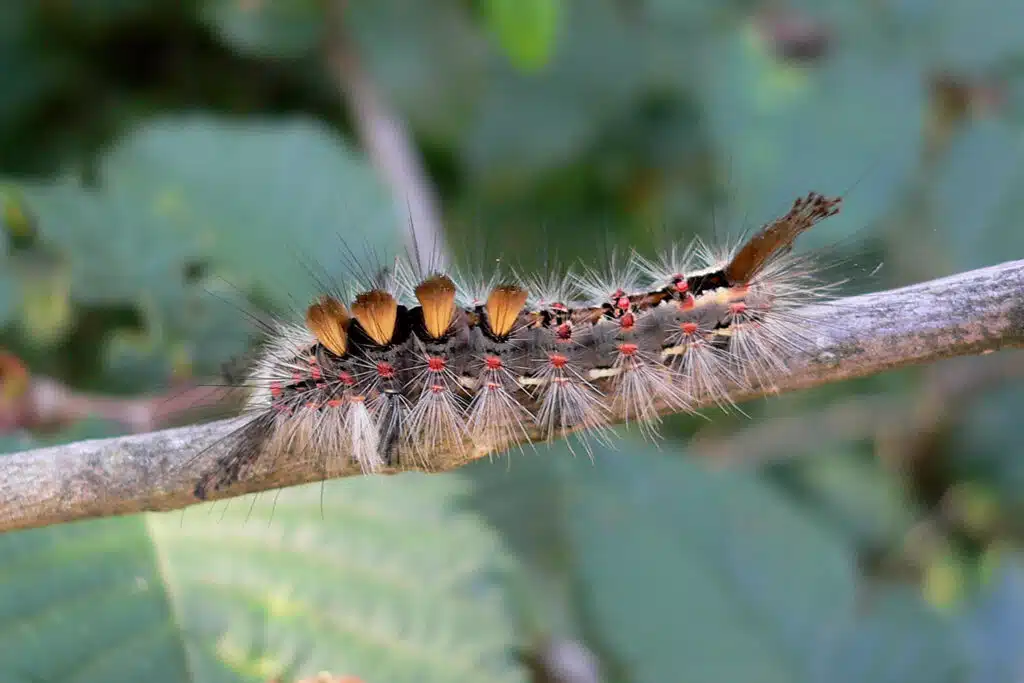
Much of the life of the Vaporer Caterpillar (Orgyia antiqua) is marked by its orange body.
Its coloring becomes more diverse as it approaches its maturity stage. This caterpillar has a black body with orange stripes and 4 yellow defensive glands.
White hairs and black tufts are specific to the species.
Various species of plants and trees are the ideal hosts of the species.
You can find it on willow, oak, and hazel hosts.
No major impact is noted on any of these hosts. However, its hairy body and its defensive glands are known to trigger skin-level rashes.
25. Silvery Checkerspot Caterpillar
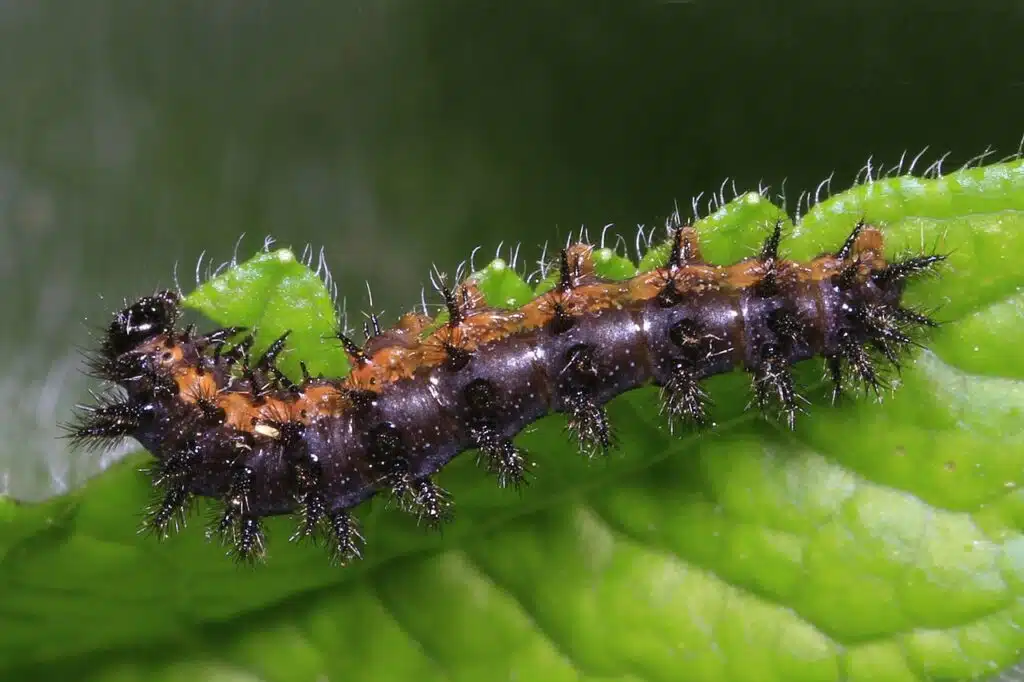
Various types of asters are the hosts of the widespread Silvery Checkerspot Caterpillar (Chlosyne nycteis).
A common sight in the US and Canada, this species is known for its multiple morphs.
A base black color is specific to the Silvery Checkerspot Caterpillar in its multiple morphs.
White or yellow marks and stripes can sometimes be spotted on some of these caterpillars.
The coloring is also present on the adult butterfly with its yellow-orange nuances with thick black borders.
26. Wild Forget-me-not Moth Caterpillar
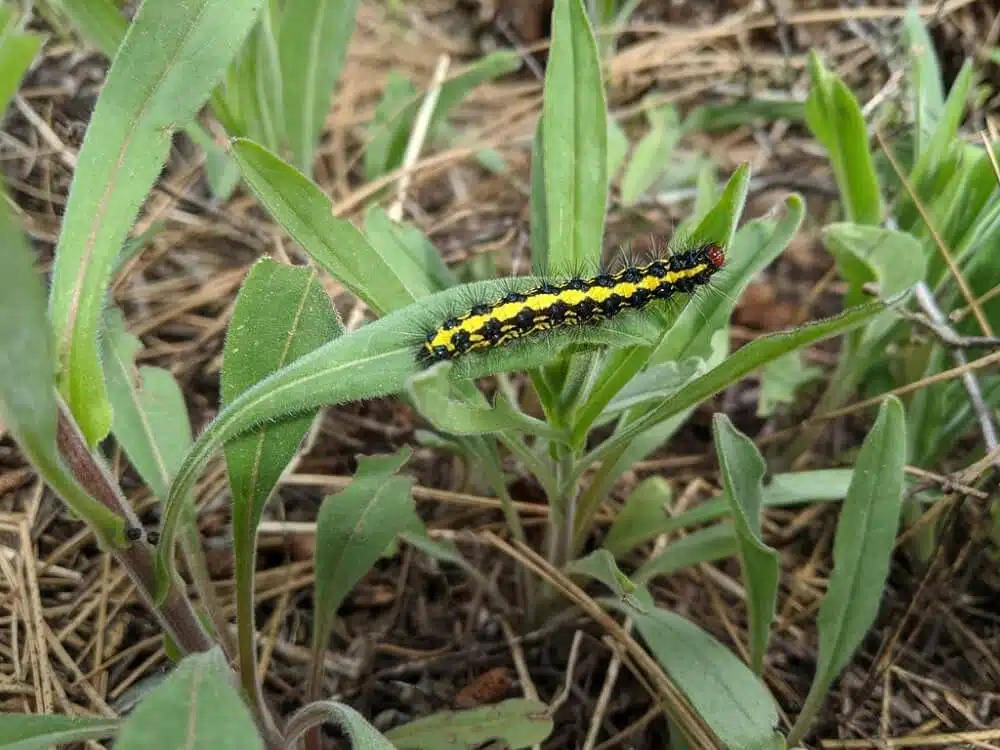
Wild Forget-me-not Moth Caterpillars (Gnophaela latipennis) are seen across Western parts of the US, including Nevada.
This species prefers woodlands and dry areas.
It can be identified by its highly contrasting black and yellow coloring.
A base black color is backed by dorsal and lateral yellow bands.
Black spines are seen covering its body from the head to the anal plate.
California stickseed and other white, blue, purple, and yellow flowers are the common hosts of the species.
27. Spotted Tussock Moth Caterpillar
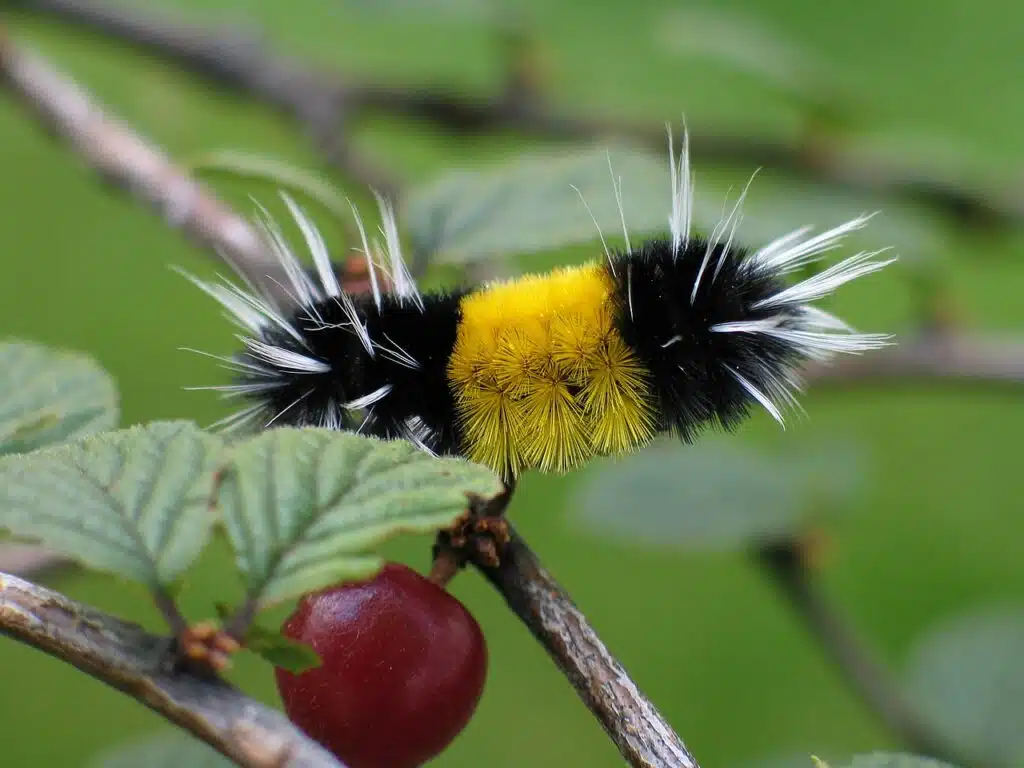
These types of caterpillars (Lophocampa maculata) grow to a black body with a wide yellow saddle.
White hairs are also seen covering the hairy black sections of this species.
Spotted Tussock Moth Caterpillars are sometimes spotted in deciduous woodlands.
Oak and birch are among the common hosts of the species.
Rare defoliation problems have been tied to this species. Parasitoid wasps lay eggs in these caterpillars before they overcrowd a host tree.
28. Leafy Spurge Hawkmoth Caterpillar
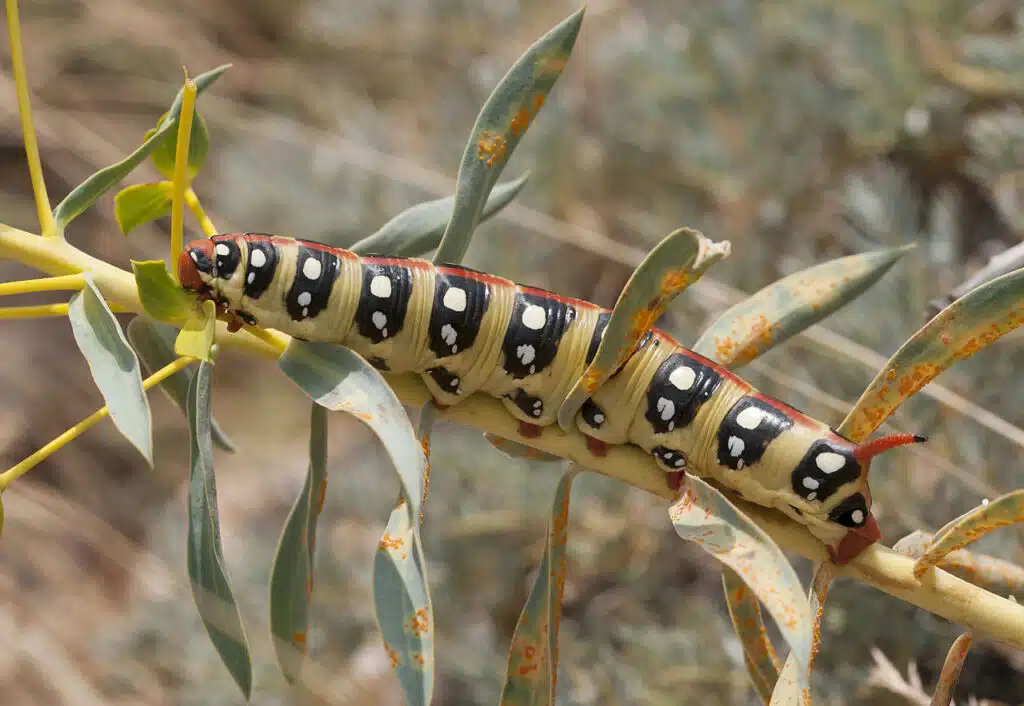
This caterpillar (Hyles euphorbiae) is part of a small group of beneficial species used to control invasive weeds in North America.
The Leafy Spurge Hawkmoth Caterpillar is used as a biological control agent against leafy spurge.
A type of weed, leafy spurge is noxious to plants around or underneath it.
The caterpillar has a hairless black body with tiny white dots and red horns.
A red head is also contrasting its black body.
The caterpillar also shows a contrasting lateral yellow band as it approaches its final instars.
29. Virginia Ctenucha Moth Caterpillar
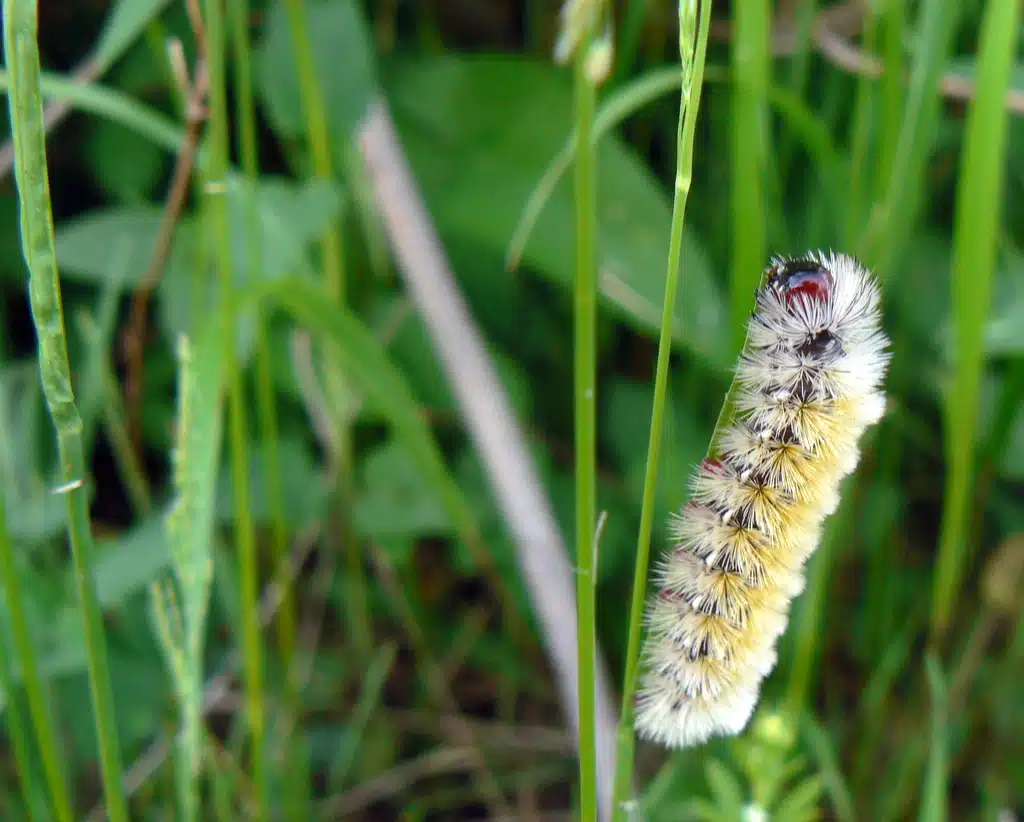
This type of caterpillar (Ctenucha virginica) is named after its natural Virginia habitat, but it has a widespread Northeastern US habitat.
Virginia Ctenucha Moth Caterpillars have alternating black and yellow hairy body.
These caterpillars are a common sight in open areas and around water where they feed on sedges and grasses.
Adult moths of the species move on to flowers such as goldenrod for nectar.
30. Banded Tussock Moth Caterpillar
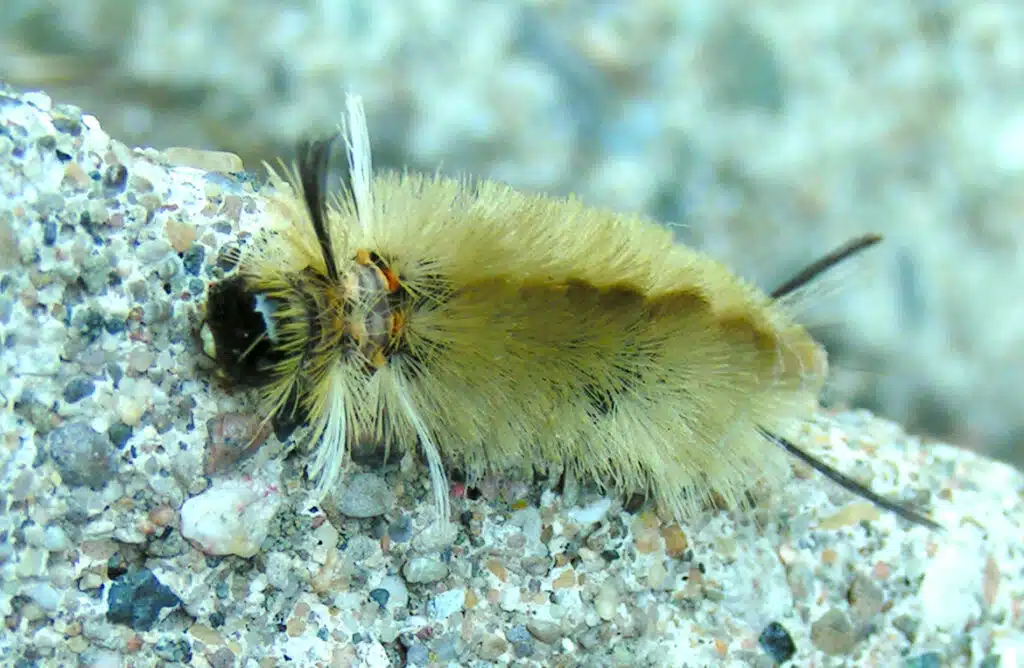
These types of caterpillars (Halysidota tessellaris) are widespread around North America but aren’t seen as major pests.
Banded Tussock Moth Caterpillars have a pale color at first which becomes golden-yellow.
Black tufts are seen on both ends of its body.
This type of caterpillar is known for having a bad taste through absorbing plant toxins.
The species may also cause skin rashes.
Banded Tussock Moth Caterpillars are spotted at the end of the summer or at the beginning of the fall on alder, ash, and other trees.
31. Clymene Moth Caterpillar
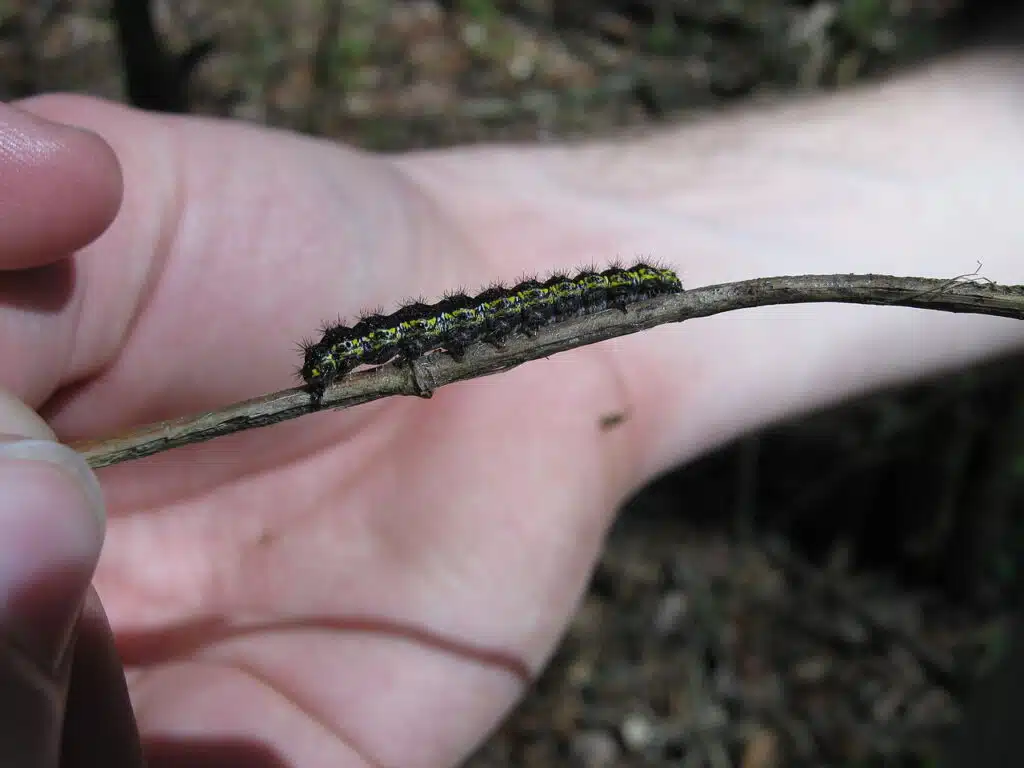
Clymene Moths (Haploa clymene) are known for having contrasting white and black cross-shaped appearances.
The caterpillar of the species is mostly black. It has wide lateral yellow bands on the lower sides of its body.
Black spines also decorate the black body of the caterpillar.
A common sight on flowering asters of various colors, Clymene Moth Caterpillars can also feed on willow and oak tree leaves.
Damages to these trees are minimal.
The species is found in Eastern US habitats and in high numbers across Southeastern Canada.
32. Grapeleaf Skeletonizer Moth Caterpillar
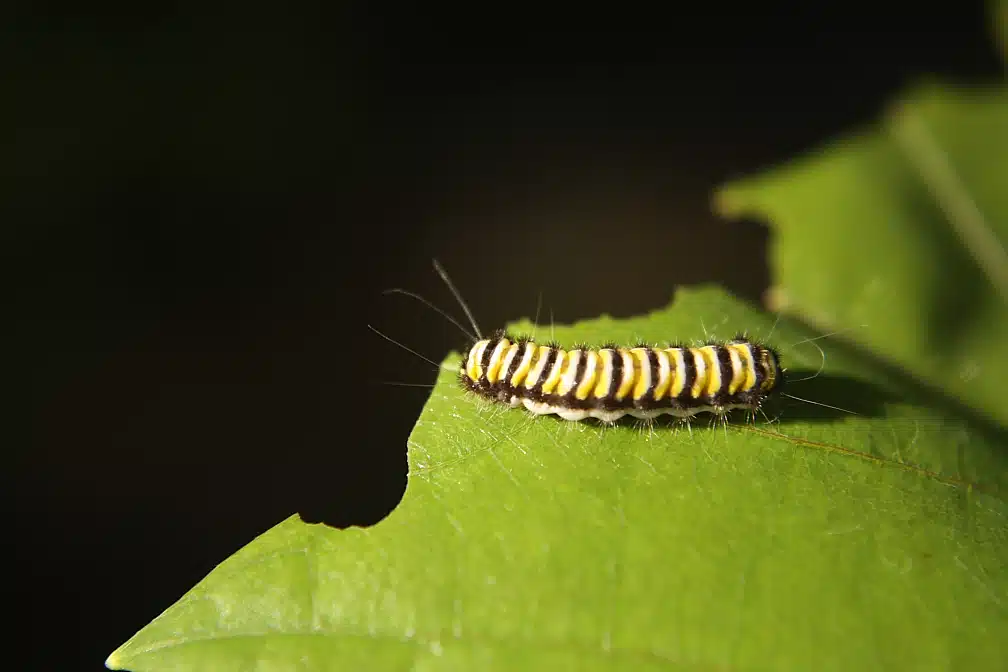
Vineyards across Florida are among the common habitats of the Grapeleaf Skeletonizer Moth Caterpillar (Harrisina americana).
This species appears in groups of yellow eggs at first. It goes through all of its instars within 40 days.
A yellow body with tiny black dots in rows is specific to the emerging caterpillar.
As it grows, these dots become black bands so that the caterpillar has alternating yellow and black bands across its body.
Wild and cultivated grapes can be invaded by this species. Young grape leaves are always at higher risk as they’re softer.
33. Reversed Haploa Moth Caterpillar
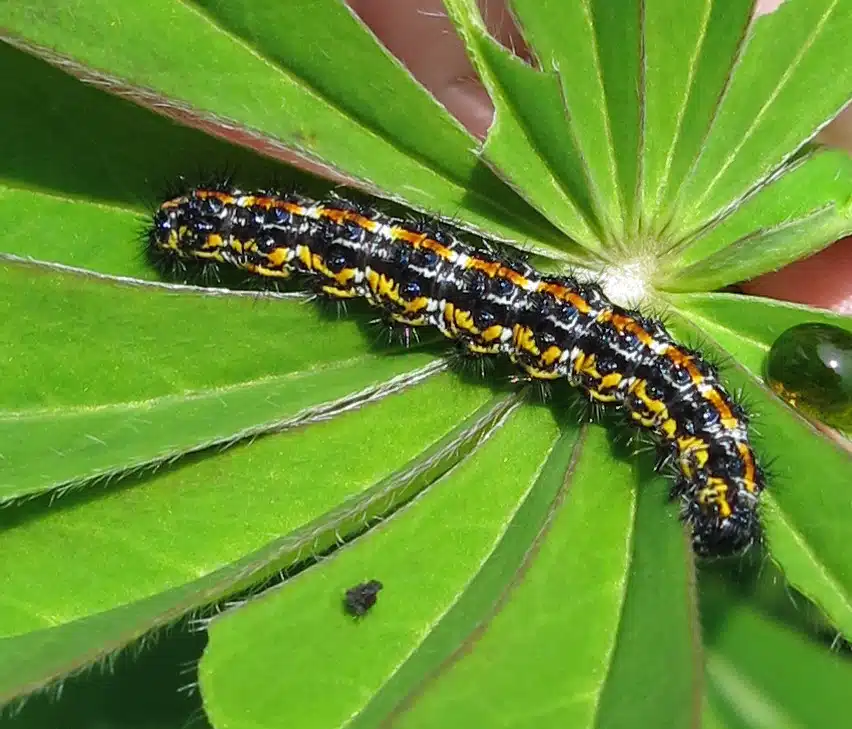
Oak woodlands and even dunes with low vegetation can be habitats for the Reversed Haploa Moth Caterpillar (Haploa reversa).
This species is known for its black color with contrasting bands appearing on it at a later stage.
Yellow and orange stripes appear on the species with a faint white stripe visible across its body in its last instar.
Various types of apple trees are hosts to the Reversed Haploa Moth Caterpillar.
As it pupates, the species turns into a mostly white moth with golden-brown marks and margins.
34. Rice Paper Butterfly Caterpillar
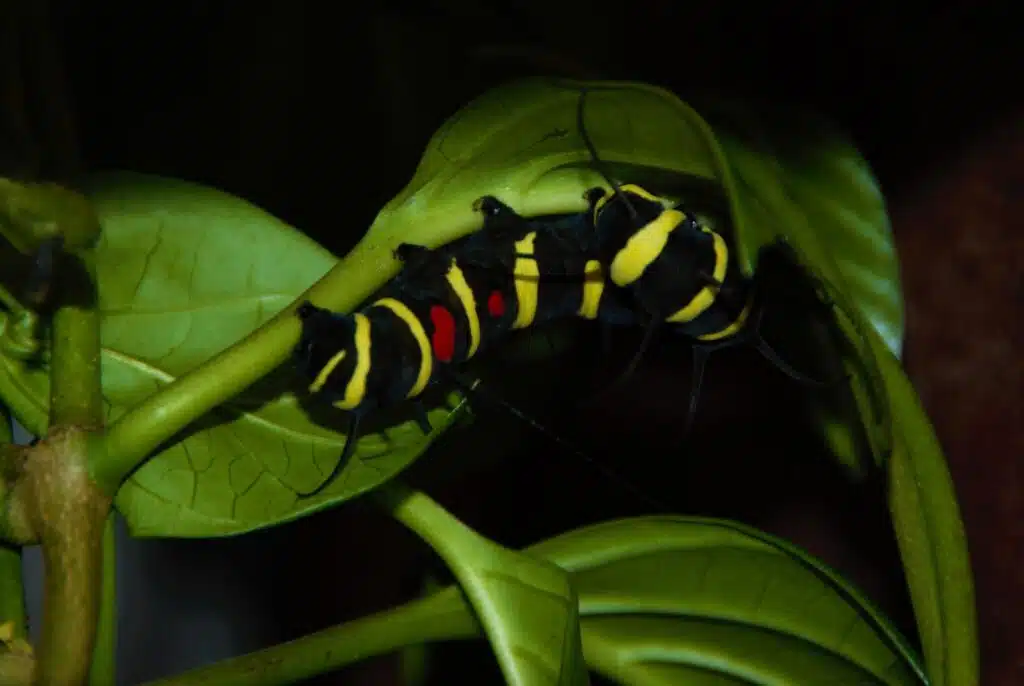
Rice Paper Butterflies (Idea leuconoe) have a pale yellow to white color with black veins and black margins.
These colors are also present on the caterpillar of the species, but at different growth stages.
White and black coloring is specific to the early growth stage caterpillar.
Red marks appear on its body at a later stage. This caterpillar turns black and white or black and yellow before pupation.
The pupa of the species is yellow with rows of black spots.
This yellow and black pupal stage lasts up to 2 weeks before the yellow and black butterfly emerges.
35. Catalpa Sphinx Caterpillar
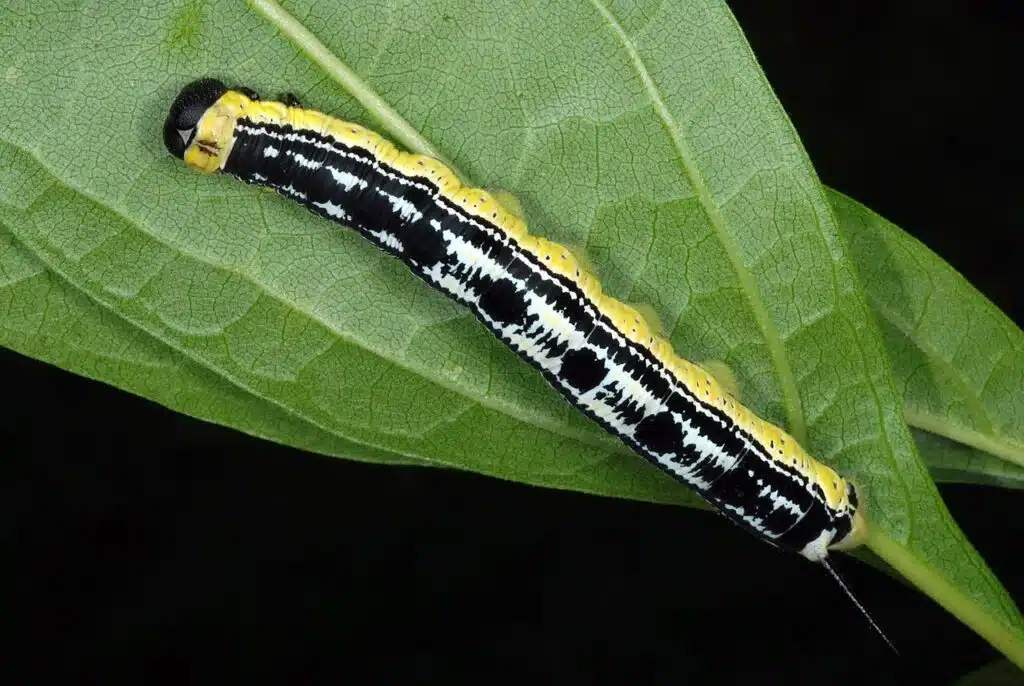
Catalpa Sphinx Caterpillars (Ceratomia catalpae) have a widespread distribution in North America.
The species is found in a habitat expanding from New York to Florida and Westwards to Texas and Nebraska.
This is one of the caterpillar species that inverts its colors as it grows.
The early-stage caterpillar is white with just a few black marks and sporadic yellow marks.
It eventually turns black with smaller white and yellow marks across its body.
As its name suggests, it uses catalpa as a host.
Emerged adults have a gray-brown color.
36. Striped Garden Caterpillar Moth
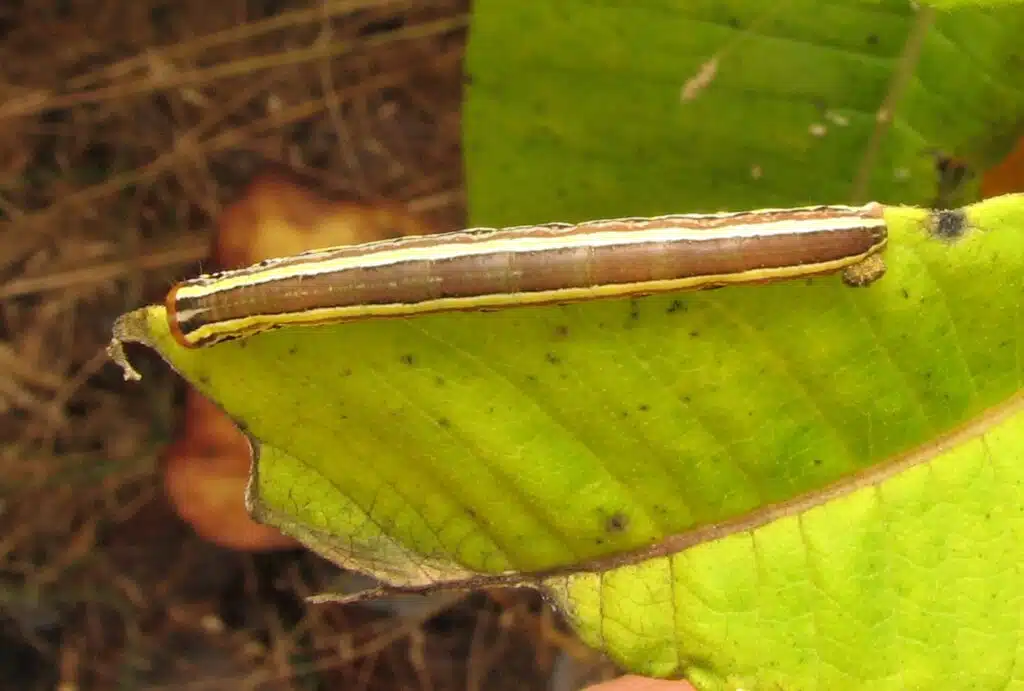
The Striped Garden Caterpillar Moth (Trichordestra legitima) only has a striped appearance in its caterpillar stages.
It begins life as a striped brown and yellow caterpillar.
It later turns into a brown and yellow striped caterpillar.
Management techniques are required against the Striped Garden Caterpillar which may be a considerable pest on crops and in orchards.
This species is seen in tobacco, raspberry, and clover fields. It also feeds on various types of flowering asters.
37. Two-barred Flasher Caterpillar
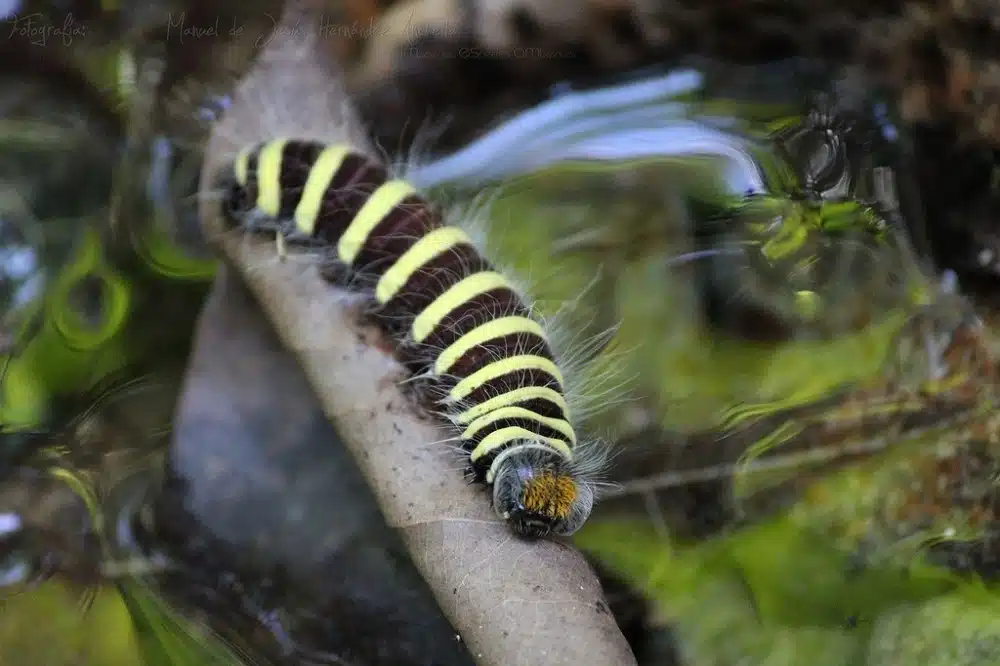
A rare sight in North America, Two-barred Flasher blue butterflies (Astraptes fulgerator) are only present in the extreme South.
This species is sometimes spotted across Southern Texas, Arizona, and New Mexico.
Apart from its distinct partly blue color, this species is also known for having a caterpillar that can resemble Monarch Caterpillars.
Two-barred Flasher caterpillars have a black body contrasted by alternating white and yellow bands.
The yellow bands are wider than the white bands on the species.
Bean family plants, mallows, and soapberry are among the most common hosts of the Two-barred Flasher Caterpillar.
38. Chain-dotted Geometer Caterpillar
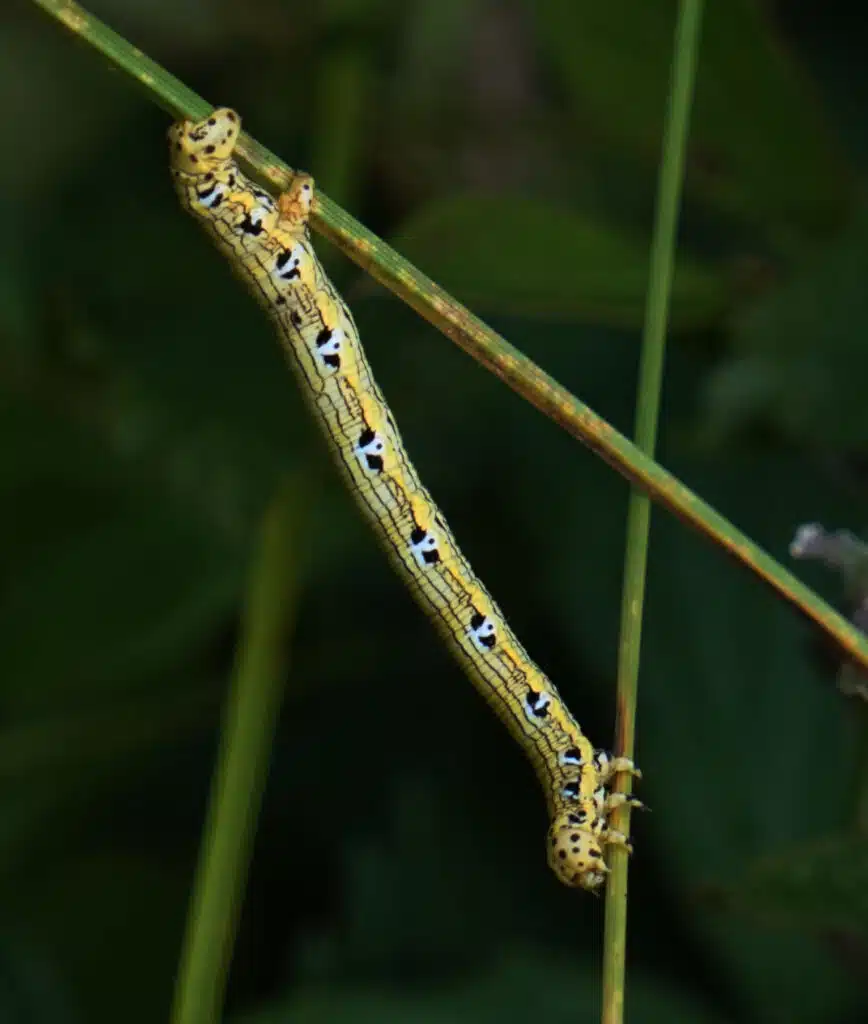
There’s almost no resemblance between the caterpillar and the Chain-dotted Geometer moth (Cingilia catenaria).
White is the dominant color of the adult moth of the species.
A yellow body dominates the dorsal and ventral side of the Chain-dotted Geometer Caterpillar.
This is a species that becomes yellow and black as it initially appears white.
The first 2 instars of the Chain-dotted Geometer Caterpillar are marked by a white body with thin black lines and lateral yellow spots.
While a colorful species, this caterpillar feeds on common tree leaves such as on the leaves of alder.
39. Nevada Buck Moth Caterpillar
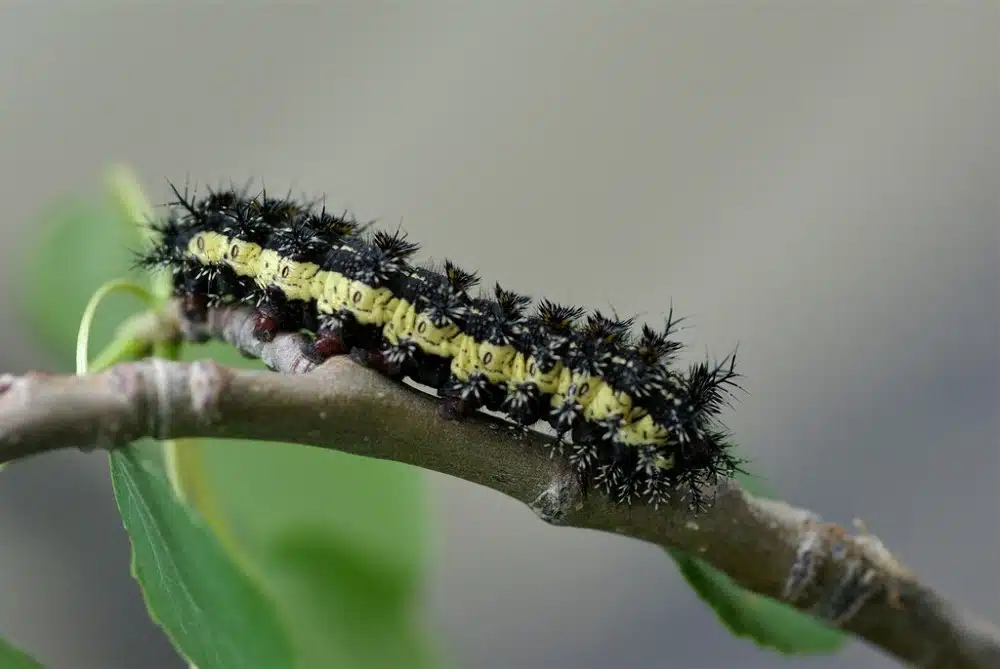
Nevada Buck Moths (Hemileuca nevadensis) are a rare sight in North America.
This species bear resembles in colors and patterns from the caterpillar to the adult moth stage.
Black color is specific to the caterpillar which has wide white bands across the dorsal and lateral sides.
Short black spines are also seen on the central dorsal side of the species.
With a growing habitat from Nevada to Michigan, this species feeds on tree leaves.
Willows are among its preferred hosts as Nevada Buck Moths live in areas close to water.
40. Funerary Dagger Caterpillar
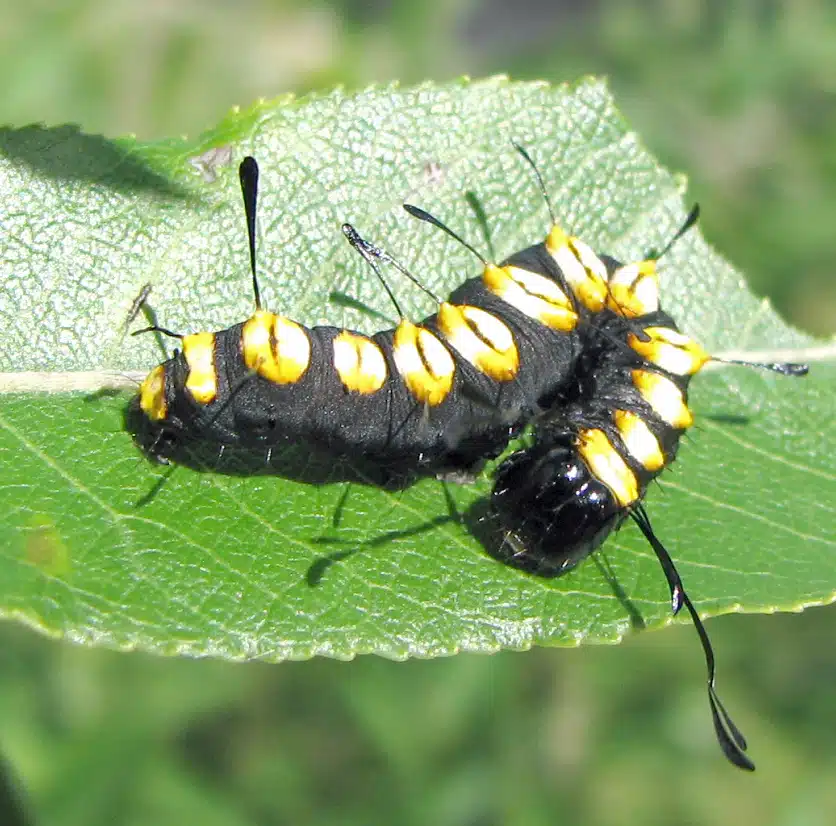
A minor pest in Northeastern and Northwestern US habitats, the Funerary Dagger Caterpillar (Acronicta funeralis) has a unique black and yellow appearance.
This species has a black body with concentric yellow circled across the central dorsal side of the species.
A central black stripe contrasts these yellow circles making it appear as if the species has longitudinal eyespots on its dorsal side.
Hazel, cottonwood, and apple are a few of the common hosts this species can impact.
The caterpillar may also be found on common hardwood tree species such as oak and alder.
41. Gilded Seedcropper Caterpillar
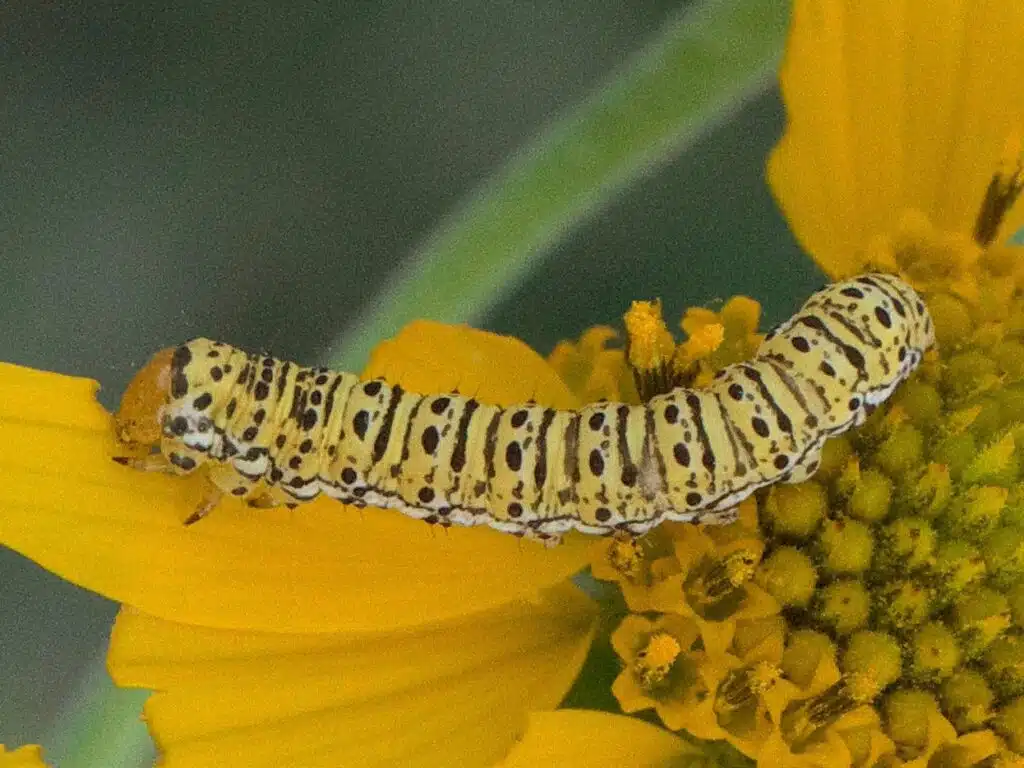
This type of species (Basilodes chrysopis) has similar coloring on the caterpillar and the emerged moth.
Gilded Seedcropper Caterpillars have yellow and white bands across the body in their early growth stages.
This species also shows tiny black spots in rows.
As it grows, these tiny black spots become wide black bands across the dorsal side of the caterpillar.
Lateral black and yellow bands also develop on the species.
Various types of asters are hosts of the species.
Yellow flowering asters such as golden crownbeard are the hosts of the species.
42. Sagebrush Sheep Moth Caterpillar
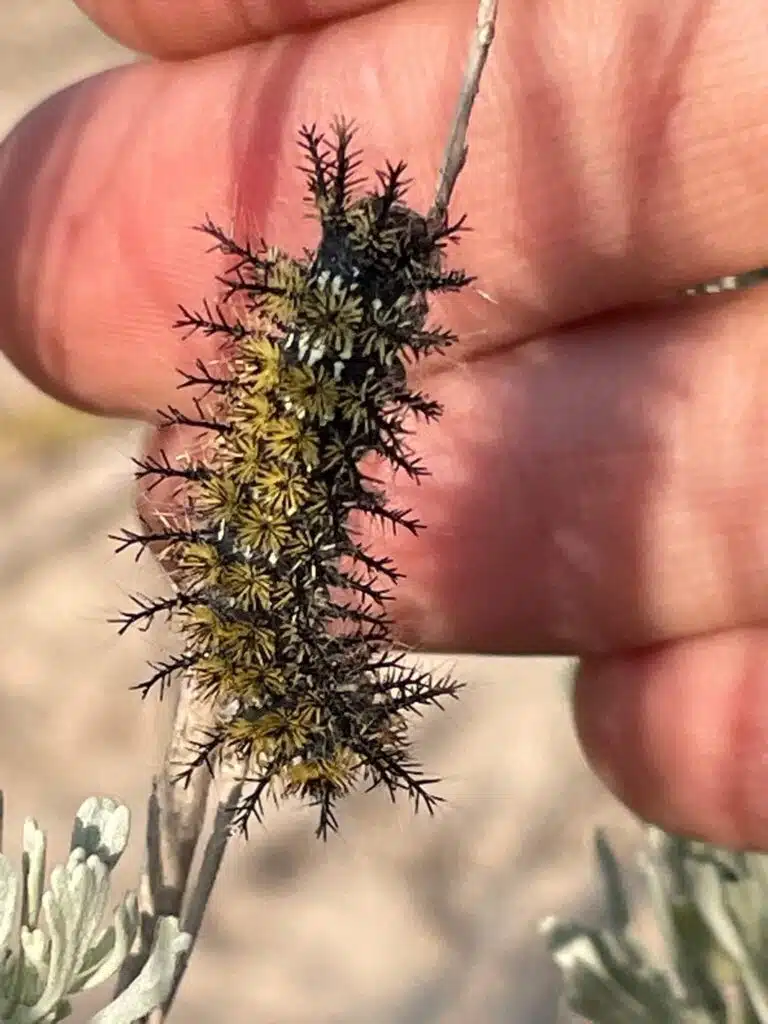
Sagebrush Sheep Moth Caterpillars (Hemileuca hera) are named after their multiple types of sagebrush hosts.
Known for growing in the most adverse conditions, sagebrush can be highly impacted by this caterpillar.
From a distance, this caterpillar appears almost completely black. Short yellow hairs make it look a bit more distinct.
White, black, and yellow-orange colors are also specific to most Sagebrush Sheep Moth.
Territories both East and West of The Rocky Mountains are home to these caterpillars.
43. Impressive Dagger Caterpillar
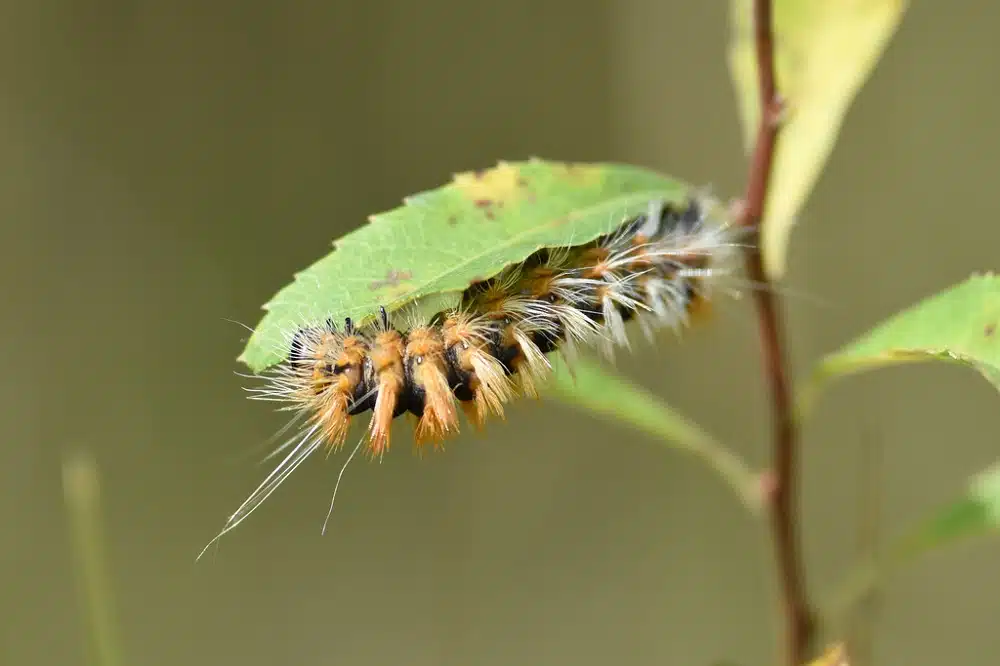
Bitterbrush and aspen are among the typical Impressive Dagger Caterpillar (Acronicta impressa) hosts.
The species is known for being black with yellow bands in its first growth stages.
A red-brown color later appears at both ends. Yellow coloring only appears on these black caterpillars in their last instars.
Damages to host plants tend to be minimal as this species rarely defoliates its host.
Once an adult, the Impressive Dagger Moth changes colors to nuances of gray, black, and brown.
44. Radcliffe’s Dagger Caterpillar
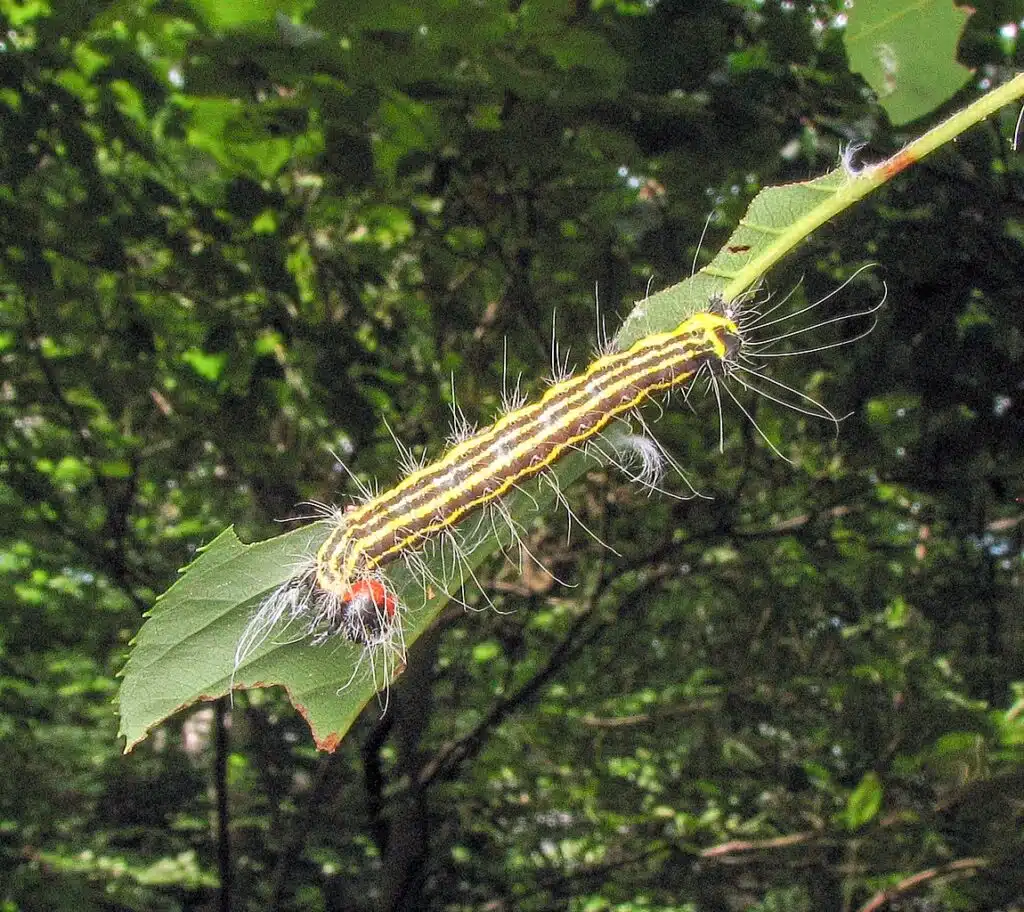
A series of hardwood trees including ash are the hosts of Radcliffe’s Dagger Caterpillar (Acronicta radcliffei).
This is a species known for changing its colors as it grows.
A base green color with a wide brown dorsal band is specific to this caterpillar.
As it grows, the base green color becomes black and the lateral bands become yellow.
Only scarce long white hairs seen in the first days of the caterpillar remain consistent up to its last instar.
The species is prevalent in Northeastern US territories with a growing presence in Northwestern territories of Washington and British Colombia.
45. Toadflax Brocade Moth Caterpillar
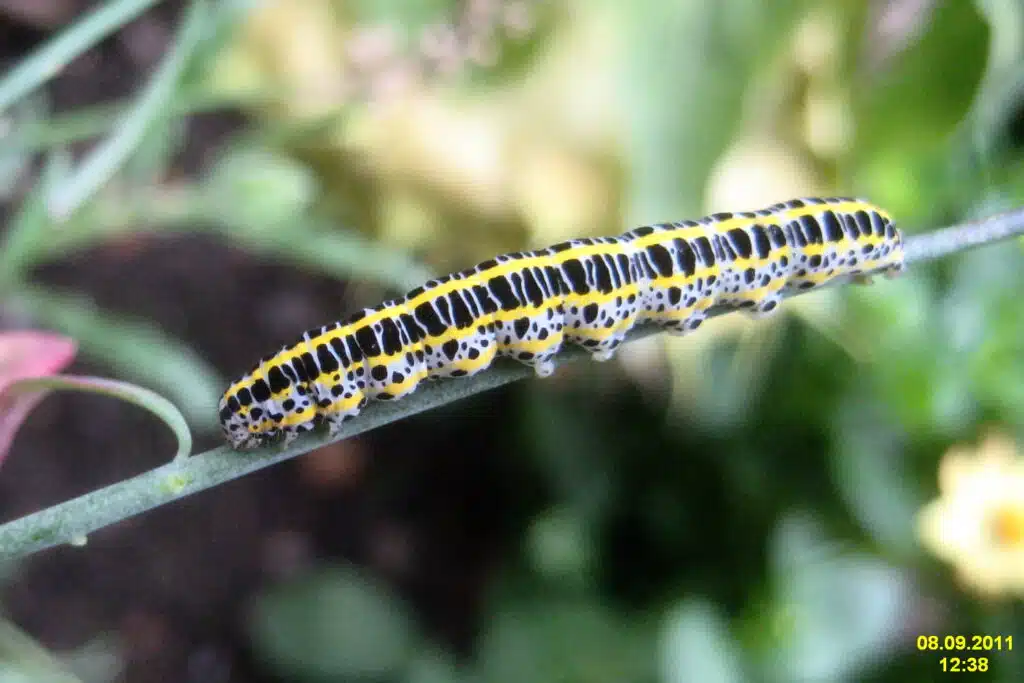
Toadflax Brocade Moth Caterpillars (Calophasia lunula) are native to North America and Europe.
This species is among the few beneficial 2-brood caterpillars in North America.
With an introduced status, Toadflax Brocade Moth Caterpillars are known to eat and eliminate Yellow Toadflax, a type of weed with yellow flowers.
The caterpillar has light and dark yellow nuances as well as black stripes and black tiny dots.
A mid-dorsal central yellow stripe is also characteristic of the species.
These colors and patterns remain constant on the caterpillar as it grows.
46. Neighbor Moth Caterpillar
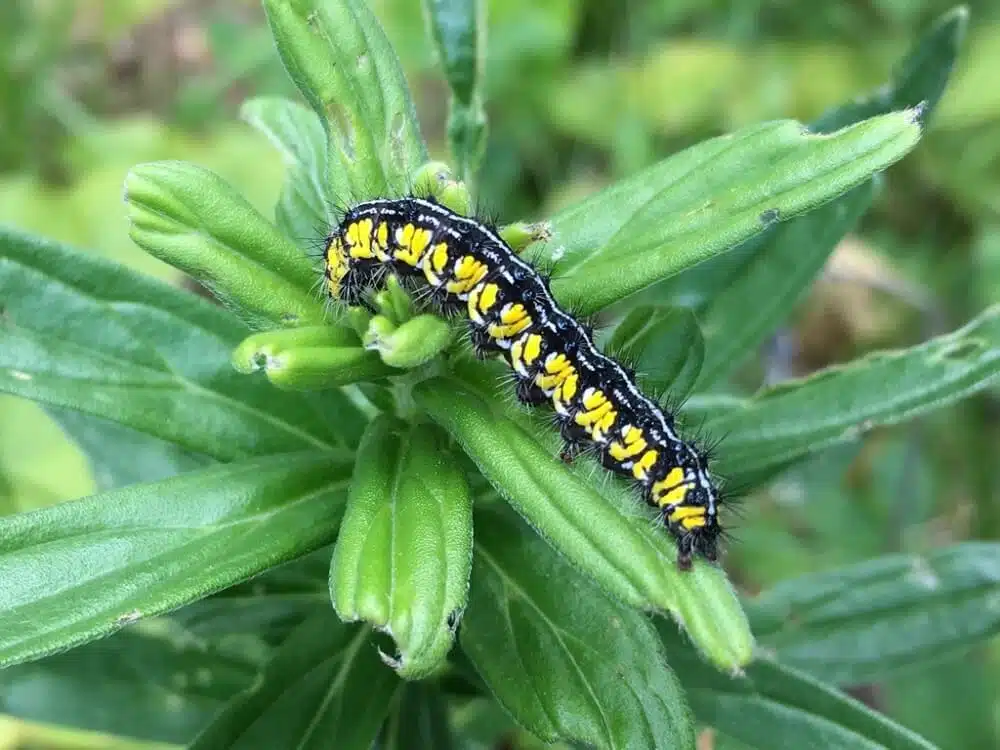
Hazel, walnut, and oak trees are among the hosts of the Neighbor Moth Caterpillar (Haploa contigua).
Neighbor Moths have a base white color with contrasting black bands across their wings.
A highly contrasting appearance is also notable when it comes to the caterpillar.
Mostly black, the caterpillar features yellow lateral clumps that form lateral bands. Spiny black hairs are also visible in the species.
This species is native to Eastern US habitats except for Florida.
47. Zebra Caterpillar Moth
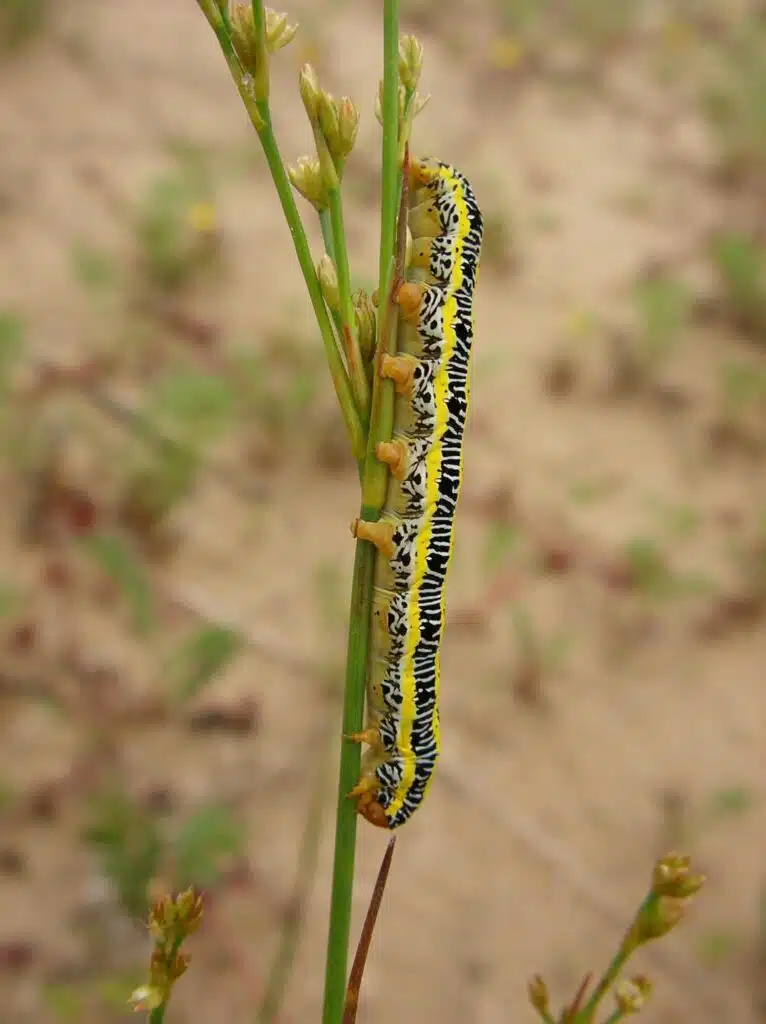
Zebra Caterpillar Moths (Melanchra picta) are a known pest on North American crops.
Specific action such as using pesticides is often a solution when it comes to these caterpillars.
Cabbage, clover, and alfalfa crops are often invaded by the species together with wild plants such as those in the pea family.
Zebra Caterpillar Moth caterpillars have visible wide yellow bands with black and white patterns in-between.
The head of the species has a contrasting brown color.
48. Three-spotted Nola Moth Caterpillar
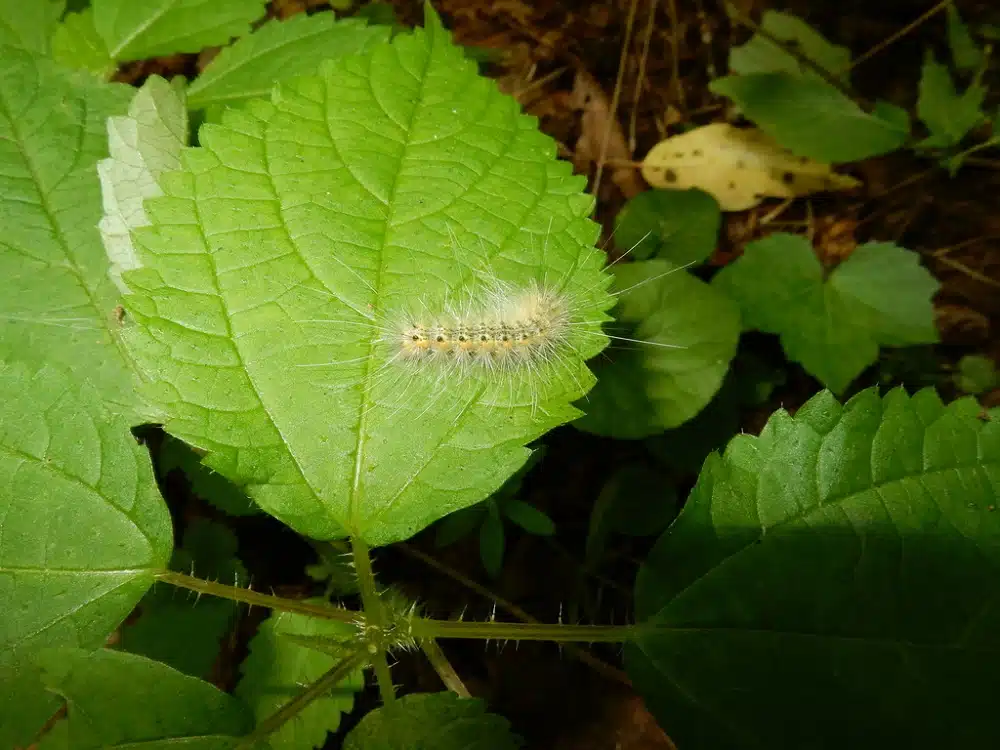
Three-spotted Nola Moth Caterpillars (Nola triquetrana) have a pale mustard-yellow color in incipient growth stages.
A darker yellow color with black spots is specific to the caterpillar as it grows.
The pest status of the species is still unclear. However, it can be seen as one of the caterpillars that eats witch hazel, an ancient plant still used for its health benefits.
Three-spotted Nola Moth Caterpillars have a growing US habitat but remain dominant in New York, Maryland, and Pennsylvania.
49. Goldenrod Flower Moth Caterpillar
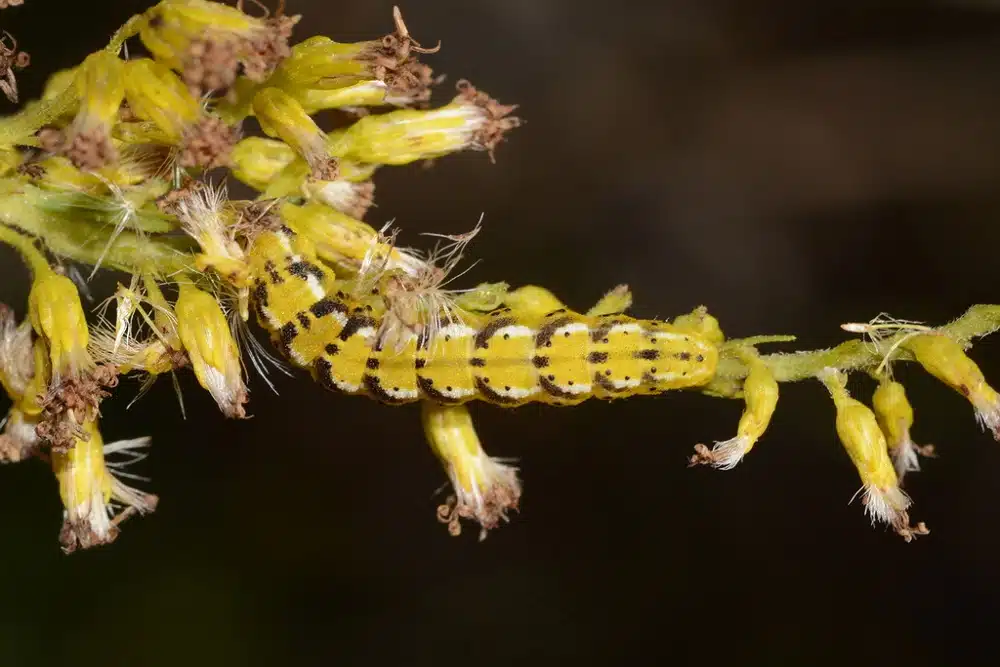
Goldenrod Flower Moth Caterpillars (Schinia nundina) are named after their main host plants, goldenrods.
This species also feeds on various types of yellow flowering asters.
Yellow is the main color of the caterpillar. As for goldenrods, the yellow nuance of the species is darker and similar to gold.
Black bands with white margins are seen on the dorsal side of the species. Smaller black spots are further distinguished on their lateral sides.
50. Texas Buck Moth Caterpillar
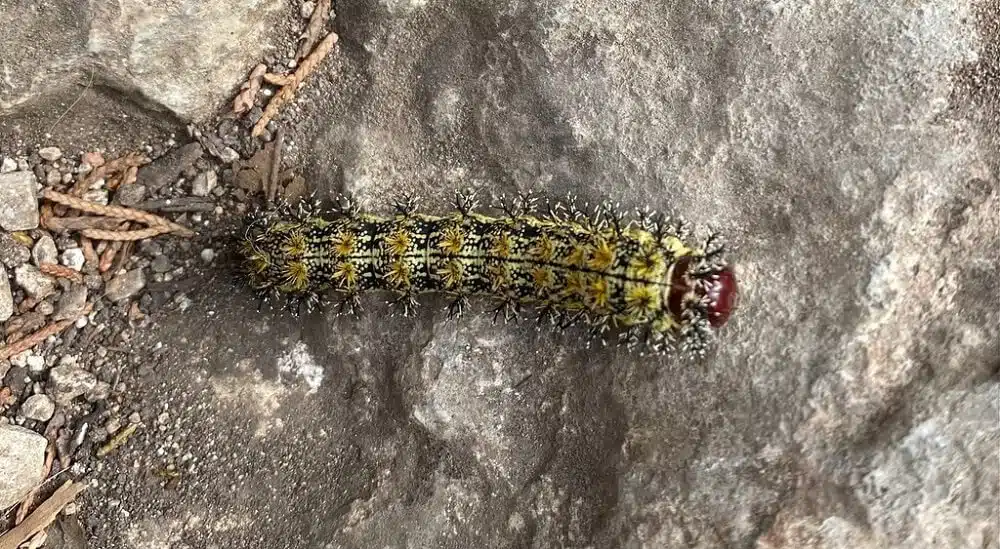
Texas Buck Moth Caterpillars (Hemileuca peigleri) are among the few stinging caterpillars in North America.
Handling this species may lead to urticaria, a mild skin condition that can be followed by rashes and welts.
This type of moth has long spikes connected to poison glands. These poison glands cause urticaria.
While stings aren’t life-threatening, this caterpillar has become a problem in multiple areas of the US including Virginia.
A black body with large yellow-orange spikes and additional black spikes is specific to this species.
The yellow-orange spikes appear later in its developmental stage.
No additional hairs or spikes grow on its body except the black and yellow ones.
51. White Flannel Moth Caterpillar
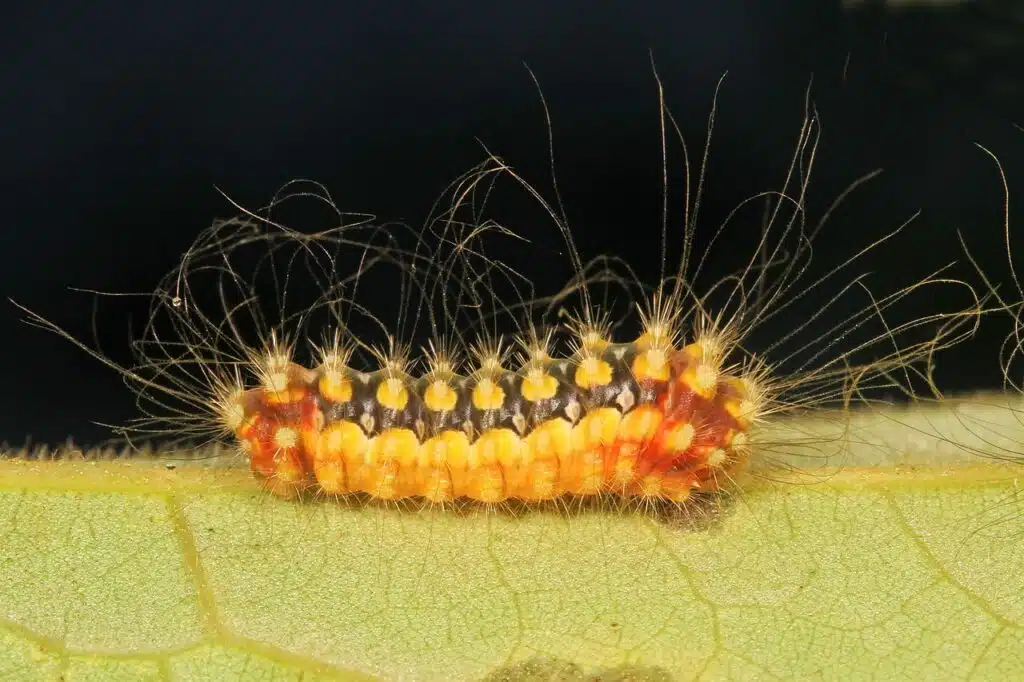
This type of caterpillar (Norape cretata) is often seen as poisonous by birds and wasps due to its multiple yellow marks across its dorsal side.
White Flannel Moth Caterpillars use vivid contrasting colors to signal a potentially poisonous nature to their predators.
The species is among the few caterpillars with a yellow ventral color and a black dorsal color.
Additional yellow dorsal marks and a red to brown head make the multicolored species appear dangerous.
Later growth stages of the caterpillar also come with scarce long hairs that don’t have urticating risks.
This species feeds on hackberry leaves and pea family plant leaves.